- Games, topic printables & more
- The 4 main speech types
- Example speeches
- Commemorative
- Declamation
- Demonstration
- Informative
- Introduction
- Student Council
- Speech topics
- Poems to read aloud
- How to write a speech
- Using props/visual aids
- Acute anxiety help
- Breathing exercises
- Letting go - free e-course
- Using self-hypnosis
- Delivery overview
- 4 modes of delivery
- How to make cue cards
- How to read a speech
- 9 vocal aspects
- Vocal variety
- Diction/articulation
- Pronunciation
- Speaking rate
- How to use pauses
- Eye contact
- Body language
- Voice image
- Voice health
- Public speaking activities and games
- Blogging Aloud
- About me/contact

How to write a speech introduction
12 of the best attention getters to start a speech
By: Susan Dugdale | Last modified: 01-12-2023
The audience settles in their seats. The lights dim. You walk out to the center of the stage. You pause, take a deep breath, open your mouth and begin.
What you say over the next 30 seconds to introduce your speech or presentation is crucial.
That's how much time you have to make a positive impression on your audience. In it they will decide whether or not you have anything relevant or useful to say. Those first impressions count!
So how do you write an effective speech introduction to grab and hold their attention?
Begin by finding out how to choose the right opener.
What's on this page:
- how to choose the right opener for your speech
12 of the very best ways to start a speech
3. What if?
5. Key fact
7. Rhetorical
9. Headlines
10. History
11. Challenge
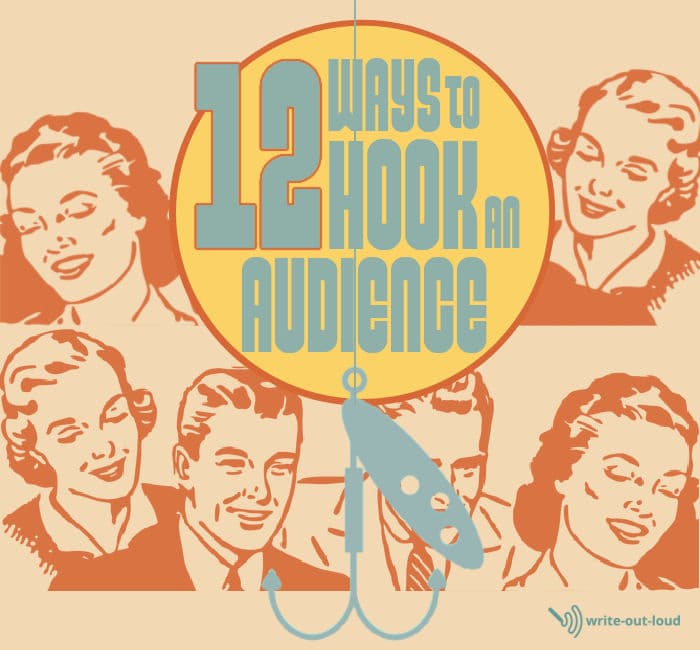
How to choose the right opener for your speech
The better way to make your choice of opener is after you have carefully considered who you are talking to and why you're talking to them.
One size does not fit all. Different audiences will respond differently. If you are giving the same speech multiple times think about what you may need to change to fit.
To work well your opening needs to be aligned with:
- the type of speech you're giving
- your main purpose for giving it
- your target audience and,
- their interests or needs
Both the hook * to catch their attention and your topic must be relevant to them. Unless they're a captive audience, they've come freely to listen to you and they're expecting something of value from you.
How are you going to let them know they're in the right place? Why should they listen? What are they going to get or gain through listening?
Out of all the different ways to open, what attention getter is absolutely the best way?
The only way I know to work out what is best is to go through each of them, and as you do, consider your audience. Make a short list of those you think might work then try them out before making your final choice.
* hook – an opening statement that immediately captures the audience's attention just like a well baited hook on a fishing line catches a fish.
Return to Top
1. Use imagination to create mind pictures
Ask the audience to use their imagination. Get them to build evocative compelling images in their minds. Make them large. Add vibrant color, sound and movement.
For example:
“Let's take a break. Make yourself comfortable. Now close your eyes for a moment. Take a deep breath, and you're there, in the place where you feel the most at ease, the place where all the tensions, all the demands of your normal everyday life disappear. Look around you. See it. Feel it. It's so good, it's perfect."
“Close your eyes. Take a deep breath and a moment to picture in your mind the people dearest to you, the people you feel you could not live without. Now when did you talk to them, or spend real time with them last?"
2. Use an item to build a connection
Choose an image or an object related to your speech, for instance a pair of shoes, to trigger interest and build a connection.
For example, if I were giving a speech on the lives of upper-middle class 19th century women I could open by holding up a pair of ornately decorated kid leather pumps.
“What's the name of the young woman who wore these? Listen. Can you hear the rustle of her silk skirts? And hear her heart beat bom-biddy-bom as the beau of the ball stepped her way? Would he, or wouldn't he ask her to dance?”
3. Ask a 'What if...?' rhetorical question
'What if...?' invites an audience to consider the possibilities of something becoming real. They can be positive somethings or negative, trivial or something that would have a significant impact if it came to pass.
The power of a 'what if...?' rhetorical question as an opener lies in the potency of the images and feelings it triggers. A well-chosen 'what if...?' will immediately have an audience wanting to hear the rest of your speech.
- "What if we don't find a way to successfully manage climate change?"
- "What if we really did solve the affordable housing crisis?"
- "What if questions of race and color ceased to matter?"
- "What if medicines were freely available to everybody who needed them?"
- "What if the person sitting next to you turned, looked into your eyes and said they loved you? Truly. Madly. Deeply."
4. Try a quotation from someone who's impacted your life in some way
To be effective a quotation doesn't have to be the clever quip or snippet of enduring wisdom: a famous quote from a well known person. It's origin could be personal, something someone important in your life said that's remained with you.
For example, my Mother answered all initial wails of outrage, pain or hurt from any of her five children with a command. "Breathe!" That was repeated, interwoven with encouraging asides, until whoever it was, was able to talk clearly and be understood. "It's OK.", she'd say. "Breathe. Come on. You can do it. Breathe. That's it. Keep going. Good."
Or I could use this line from one of my high school reports which read, "...with further maturity she should do well." (Thank you Mr Phillips. Your prediction was right on target.)
Or this from our son aged four as he watched me getting ready for another day of teaching: "When I grow up I'm going to wear pretty dresses and go to school just like you."
5. Use an interesting key fact
Choose an interesting key fact as an attention getting device: one of the most rarely known, or a shocking statistic from the body of your speech to open with.
For example: "Take a guess at what the most powerful and frequently used word is in the English language?
It's not one of those usually thought of candidates. Love? No. Money? Nope. Neither is it any member of your family... Mum, Dad, brother, sister, son, or daughter.
It's a three letter word, so common it's overlooked and taken for granted. 'The'. It's the humble 'the'."
(For more see this BBC article: Is this the most powerful word in the English language?
Or: "Between 2020/21 and 2021/2022, Americans consumed about 11 million metric tons of sugar, up from about 10 million metric tons in 2009/2010. Can you even begin to imagine the size of that sweet white mountain?"
(For more see: US sugar consumption statistics )
6. Share personal stories
Share a personal story related to your specific topic as the beginning of a speech. Done well, it lets the audience know you understand their situation and helps establish your credibility: your right to talk on the subject.
As an example here's the opening of a speech I gave about the impact of suicide on families and friends:
“One fine Spring day I biked home from school and found a policemen guarding our backdoor. Through it came sounds I'll never forget: my quiet Mother screaming. He said, "You can't go in."
I kicked him in the shins and did. It was the 15th of September, three days before my thirteenth birthday and my father was dead. Killed by his own hand. Suicide.”
(If you want to find out more about the speech and read it, it's here: After they're gone . It's an example persuasive speech using the five steps of Monroe's Motivated Sequence.)
7. Rhetorical questions
These are questions that although they are asked, they're never really intended to be answered by anyone other than the person asking them. * Their principal function is to act as a segue, or lead in, to what the person intends to say next. For instance, the first main point of your introduction.
Examples: "What if I were to say to you that there was no such thing as public speaking fear?"
"What do you think the main benefits of being able to speak up in public are?"
* Although there's bound to be someone in your audience who will. Be ready for them, and move on.
8. An empathetic question, aligning yourself with the audience and eliciting a response
These questions bring speaker and audience together, establishing a common ground, a mutual understanding, which is an effective way to ease into a speech. If your question 'works' you'll see heads nodding in agreement.
- "Have you ever experienced the butterflies in your stomach turning into a herd of rampaging elephants, just before you step up to give your presentation?"
- "Have you ever wanted a good day to never end?"
- "How often have you 'lost' your car in the supermarket car park?"
- "How often have you ever wanted to shout, NO? You want me to prepare a new presentation by tomorrow? NO. You want me to stay late, again? NO."
9. It's in the news
Take headlines from what's trending in media you know the audience will be familiar with and see.
Using those that relate to your speech topic as the opening of your speech is a good way to grab the attention of the audience. It shows how relevant and up-to-the-minute the topic is.
For example: "'Death toll soars to 76 in Florida after Hurricane Ian demolished entire communities.' 'Noru became a super typhoon in 6 hours. Scientists say powerful storms are becoming harder to forecast.' 'Hurricane Orlene strengthens into Category 4 storm as it heads toward western Mexico.'
Three front page headlines from CNN just today. Climate change. Let's do what we can."
10. This day in history
If you're giving a speech to celebrate a special birthday or an anniversary, consider using several carefully selected events that occurred on the same day as a speech opening. They could be either funny or serious, depending on the specific purpose of your speech. They're a great way to place the person in a much wider context and often with exalted company.
For example: "What do the 1863 National Thanksgiving Day proclamation by President Abraham Lincoln, National Boyfriend Day, and Gwen Stefani have in common with Joe? Yes, the 3rd of October! It's a great date made better by being Joe's birthday. And we say Gwen is truly privileged to have the same one as him."
11. Issue a challenge
Let the audience know first thing, at the beginning of the speech, what action you expect they'll be able to take by the time your presentation is complete. Then when you come to the final points, repeat the call to action, or challenge, as part of your closing statement.
For example: "I've a challenge for you. That's to sign up for our public speaking course. Right now you may not see yourself doing that. Public speaking? Me? I'd rather have a root canal done, without painkillers. However, by the end of the presentation...well, let's see. There's a first time for everything!"
Use a startling statement, a fact, or a series of facts, to jolt the audience into paying attention.
"Covid. We've had 1.06 million of us die in the US, so far. Today there are nearly 60,00 new cases. More mothers, fathers, friends, colleagues, children – people. People ill. People who might die. So why have we stopped wearing masks?"
For more: Google: Covid stats US
Other speech writing resources
- how to end a speech effectively : explanations with examples showing how to close a speech with impact
- how to write a speech : a detailed guide with examples covering audience analysis, planning, writing oral language, transitions, how to use an outline...
speaking out loud
Subscribe for FREE weekly alerts about what's new For more see speaking out loud

Top 10 popular pages
- Welcome speech
- Demonstration speech topics
- Impromptu speech topic cards
- Thank you quotes
- Impromptu public speaking topics
- Farewell speeches
- Phrases for welcome speeches
- Student council speeches
- Free sample eulogies
From fear to fun in 28 ways
A complete one stop resource to scuttle fear in the best of all possible ways - with laughter.

Useful pages
- Search this site
- About me & Contact
- Free e-course
- Privacy policy
©Copyright 2006-24 www.write-out-loud.com
Designed and built by Clickstream Designs
- College Essay
- Argumentative Essay
- Expository Essay
- Narrative Essay
- Descriptive Essay
- Scholarship Essay
- Admission Essay
- Reflective Essay
- Nursing Essay
- Economics Essay
Assignments
- Term Papers
- Research Papers
- Case Studies
- Dissertation
- Presentation
- Editing Help
- Cheap Essay Writing
- How to Order
Speech Writing
Introduction Speech
Introduction Speech- Tips & Examples
10 min read
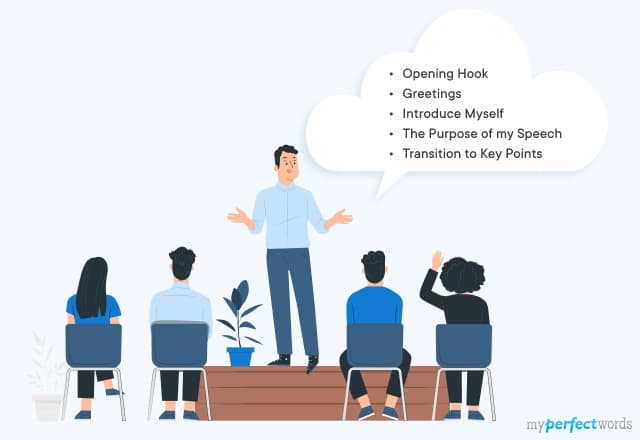
People also read
The 10 Key Steps for Perfect Speech Writing
Understanding Speech Format - Simple Steps for Outlining
How to Start A Speech - 13 Interesting Ideas & Examples
20+ Outstanding Speech Examples for Your Help
Common Types of Speeches that Every Speechwriter Should Know
Good Impromptu Speech Topics for Students
Entertaining Speech Topics for Your Next Debate
Understanding Special Occasion Speech: Types, Steps, Examples and Tips
How to Write A Good Acceptance Speech?
Writing A Presentation Speech In English: Tips And Examples
Commemorative Speech - Writing Guide, Outline & Examples
Farewell Speech | Writing Tips & Examples
How to Write an Extemporaneous Speech? A Step-by-Step Guide
A Graduation Speech Writing Guide with Examples
Introduction speeches are all around us. Whenever we meet a new group of people in formal settings, we have to introduce ourselves. That’s what an introduction speech is all about.
When you're facing a formal audience, your ability to deliver a compelling introductory speech can make a lot of difference. With the correct approach, you can build credibility and connections.
In this blog, we'll take you through the steps to craft an impactful introduction speech. You’ll also get examples and valuable tips to ensure you leave a lasting impression.
So, let's dive in!
- 1. What is an Introduction Speech?
- 2. How to Write an Introduction Speech?
- 3. Introduction Speech Outline
- 4. Introduction Speech Example
- 5. Introduction Speech Ideas
- 6. 7 Tips for Delivering the Best Introduction Speech
What is an Introduction Speech?
An introduction speech, or introductory address, is a brief presentation at the beginning of an event or public speaking engagement. Its primary purpose is to establish a connection with the audience and to introduce yourself or the main speaker.
This type of speech is commonly used in a variety of situations, including:
- Public Speaking: When you step onto a stage to address a large crowd, you start with an introduction to establish your presence and engage the audience.
- Networking Events: When meeting new people in professional or social settings, an effective introduction speech can help you make a memorable first impression.
- Formal Gatherings: From weddings to conferences, introductions set the tone for the event and create a warm and welcoming atmosphere.
In other words, an introduction speech is simply a way to introduce yourself to a crowd of people.
How to Write an Introduction Speech?
Before you can just go and deliver your speech, you need to prepare for it. Writing a speech helps you organize your ideas and prepare your speech effectively.
Here is how to introduce yourself in a speech.
- Know Your Audience
Understanding your audience is crucial. Consider their interests, backgrounds, and expectations to tailor your introduction accordingly.
For instance, the audience members could be your colleagues, new classmates, or various guests depending on the occasion. Understanding your audience will help you decide what they are expecting from you as a speaker.
- Opening the Speech with a Hook
The best speech introduction starts with a hook or opening line that grabs your audience's attention. This could be a surprising fact, a relevant quote, or a thought-provoking question about yourself or the occasion.
- Introduce Yourself
Introduce yourself to the audience. State your name, occupation, or other details relevant to the occasion. You should have mentioned the reason for your speech clearly. It will build your credibility and give the readers reasons to stay with you and read your speech.
- Keep It Concise
So how long is an introduction speech?
Introduction speeches should be brief and to the point. Aim for around 1-2 minutes in most cases. Avoid overloading the introduction with excessive details.
- Highlight Key Points
Mention the most important information that establishes the speaker's credibility or your own qualifications. Write down any relevant achievements, expertise, or credentials to include in your speech. Encourage the audience to connect with you using relatable anecdotes or common interests.
- Rehearse and Edit
Practice your introduction speech to ensure it flows smoothly and stays within the time frame. Edit out any unnecessary information, ensuring it's concise and impactful.
- Tailor for the Occasion
Adjust the tone and content of your introduction speech to match the formality and purpose of the event. What works for a business conference may not be suitable for a casual gathering.
Introduction Speech Outline
To assist you in creating a structured and effective introduction speech, here's a simple speech format that you can follow:
Here is an example outline for a self-introduction speech.
Outline for Self-Introduction Speech
Introduction Speech Example
So if you are wondering what to say in an introduction speech we have you covered! We have compiled introduction speech examples to help you understand how to put your ideas into practice for different scenarios.
Introduction Speech Writing Sample
Short Introduction Speech Sample
Self Introduction Speech for College Students
Introduction Speech about Yourself
Student Presentation Introduction Speech Script
Teacher Introduction Speech
New Employee Self Introduction Speech
Introduction Speech for Chief Guest
Moreover, here is a video example of a self-introduction speech. Watch it to understand how you should deliver your speech:
Want to read examples for other kinds of speeches? Find the best speeches at our blog about speech examples !
What Are Some Famous Introduction Speeches?
Here are the best introduction speeches for students to get inspired:
- Malala Yousafzai's Nobel Peace Prize Acceptance Speech (2014) : Malala's speech upon receiving the Nobel Peace Prize introduced her advocacy for girls' education and youth empowerment globally.
- Elon Musk's Presentation on SpaceX Interplanetary Transport System (2016) : Elon Musk introduced SpaceX's ambitious plans for interplanetary travel, outlining a vision for the future of space exploration.
- Michelle Obama's Democratic National Convention Speech (2008) : Michelle Obama's speech introduced her as a potential First Lady, sharing personal stories and values that resonated with the audience.
- J.K. Rowling's Harvard Commencement Speech (2008) : Rowling's speech introduced themes of failure, imagination, and resilience, drawing from her personal journey as an author and philanthropist.
Introduction Speech Ideas
So now that you’ve understood what an introduction speech is, you may want to write one of your own. So what should you talk about?
The following are some sample introduction speech topics and ideas that can provide an engaging start to a presentation, meeting, or social gathering.
- Personal Story: Share a brief personal story or experience that has shaped you.
- Professional Background: Highlight your career achievements and expertise.
- Hobby or Passion: Discuss a hobby or passion you're enthusiastic about.
- Volunteer Work: Talk about your involvement in volunteer work or community service.
- Travel Adventures: Share anecdotes from your travel adventures.
- Books or Literature: Provide an introduction related to a favorite book, author, or literary work.
- Achievements and Milestones: Highlight significant achievements and milestones in your life or career.
- Cultural Heritage: Explore your cultural heritage and its influence on your identity.
- Social or Environmental Cause: Discuss your dedication to a particular social or environmental cause.
- Future Aspirations: Share your future goals and aspirations.
You can deliver engaging speeches on all kinds of topics. Here is a list of entertaining speech topics to get inspiration.
7 Tips for Delivering the Best Introduction Speech
Now that you know how to write an effective introduction speech, let's focus on the delivery. The way you present your introduction is just as important as the content itself. Here are some valuable tips to ensure you deliver a better introduction speech:
Tip# 1: Maintain Eye Contact
Make eye contact with the audience to establish a connection. This shows confidence and engages your listeners.
Tip# 2: Use Appropriate Body Language
Your body language should convey confidence and warmth. Stand or sit up straight, use open gestures, and avoid fidgeting.
Tip# 3: Mind Your Pace
Speak at a moderate pace, avoiding rapid speech. A well-paced speech is easier to follow and more engaging.
Tip# 4: Avoid Filler Words
Minimize the use of filler words such as "um," "uh," and "like." They can be distracting and detract from your message.
Tip# 5: Be Enthusiastic
Convey enthusiasm about the topic or the speaker. Your energy can be contagious and inspire the audience's interest.
Tip# 6: Practice, Practice, Practice
Rehearse your speech multiple times. Practice in front of a mirror, record yourself or seek feedback from others.
Tip# 7: Be Mindful of Time
Stay within the allocated time for your introduction. Going too long can make your speech too boring for the audience.
Mistakes to Avoid in an Introduction Speech
When crafting and delivering an introduction speech, it's important to avoid common pitfalls that can reduce its impact. Here are some mistakes to watch out for:
- Rambling On: Avoid making the introduction too long. Keep it short and sweet to set the stage without stealing the spotlight.
- Lack of Preparation: Not preparing enough can lead to awkward pauses or losing your train of thought. Practice your speech to feel more confident.
- Using Jargon or Complex Language: Steer clear of technical jargon or complicated language that might confuse the audience. Keep it simple and clear.
- Being Too Generic: A bland introduction can set a dull tone. Make your speech specific to the event and the speaker to keep it engaging.
- Using Inappropriate Humor: Be careful with humor. Avoid jokes that could offend or alienate the audience.
- Overloading with Background Information: Providing too much background information can overwhelm the audience. Offer just enough to give context without bogging down the introduction.
To Conclude,
An introduction speech is more than just a formality. It's an opportunity to engage, inspire, and connect with your audience in a meaningful way.
With the help of this blog, you're well-equipped to shine in various contexts. So, step onto that stage, speak confidently, and captivate your audience from the very first word.
Moreover, you’re not alone in your journey to becoming a confident introducer. If you ever need assistance, you can place a pay to do my essay request and let the experts help you out.
MyPerfectWords.com offers a custom essay service with experienced professionals who can craft tailored introductions, ensuring your speech makes a lasting impact.
Don't hesitate; hire our professional speech writing service to deliver top-quality speeches at your deadline!
Frequently Asked Questions
How long should a speech introduction be.
A speech introduction should be concise, typically lasting about 1 to 2 minutes. It should set the stage, capture the audience's attention, and provide a clear direction for the rest of the speech.
What Is the Best Speech Introduction Greeting?
The best greeting for a speech introduction depends on the formality of the event. Some examples include:
- Formal: "Good morning/afternoon/evening, distinguished guests."
- Semi-formal: "Hello everyone, thank you for being here today."
- Informal: "Hi everyone, thanks for coming."
What Word to Start a Speech?
Starting a speech with an engaging word or phrase can capture the audience's attention. Here are a few speech starting lines:
- "Imagine..." to prompt the audience to visualize something.
- "Today..." to ground the speech in the present moment.
- "Have you ever..." to ask a thought-provoking question.
- "In our lives..." to make a personal connection.
- "Picture this..." to create a vivid mental image.

Write Essay Within 60 Seconds!

Dr. Barbara is a highly experienced writer and author who holds a Ph.D. degree in public health from an Ivy League school. She has worked in the medical field for many years, conducting extensive research on various health topics. Her writing has been featured in several top-tier publications.
Struggling With Your Paper?
Get a custom paper written at
With a FREE Turnitin report, and a 100% money-back guarantee
LIMITED TIME ONLY!
Keep reading

OFFER EXPIRES SOON!
Speech introductions
The introduction and conclusion of a speech are essential. The audience will remember the main ideas even if the middle of the speech is a mess or nerves overtake the speaker. So if nothing else, get these parts down!
Introduction
The introduction gives the audience a reason to listen to the remainder of the speech. A good introduction needs to get the audience’s attention, state the topic, make the topic relatable, establish credibility, and preview the main points. Introductions should be the last part of the speech written, as they set expectations and need to match the content.
Attention getters
The first few sentences of a speech are designed to catch and maintain the audience’s attention. Attention getters give the audience a reason to listen to the rest of the speech. Your attention getter helps the audience understand and reflect on your topic.
- Speaker walks up to stage with notes stuck to hands with jelly.
- Did you know there is a right way to make a peanut butter and jelly sandwich?
- Rob Gronkowski once said, “Usually, about 2 hours before a game, I stuff in a nice peanut butter and jelly [sandwich] with chocolate milk.”
- A little boy walks in from a long day at school, telling his mom that he is starving. His mom is confused because she knows she sent him to school with a full lunch. As she opens his lunch box, she sees his peanut butter and jelly, with the grape jelly smeared on the side of the bag. She realizes there has to be a better way to make a PB&J.
- Bring in a clear sandwich bag with jelly seeping through the bread of a peanut butter and jelly sandwich.
Logical orientation
Once the audience is invested in the speech, logical orientation tells the audience how the speaker will approach and develop the topic.
- Peanut butter on both sides of the bread with jelly in the middle is the best way to make a PB&J.
- PB&Js have developed a bad reputation, because of the jelly making the bread soggy and hands sticky.
Psychological orientation
Like the logical orientation of a speech, the psychological orientation is also going to provide the audience with a map for how and why the topic is being presented.
- Most of us remember our moms – dads too – packing a peanut butter and jelly sandwich in our lunches. We also remember how the jelly did not just stay in the sandwich, but became a new stain on our shirts and the glue that held all the playground dirt to our hands.
- We can end this torture for future generations by making sure all parents are aware of the best way to make a PB&J.
- I have eaten numerous PB&Js myself, but my real authority on the topic comes from being a mom of two boys and the maker of many PB&Js.
Both the logical and psychological orientations give the audience a road map for the speech ahead as well as cues for what to listen to. This will help the audience transition from the introduction to the main points of the speech.
Beebe, S. A., & Beebe, S. J. (2012). A concise public speaking handbook . Boston: Allyn & Bacon.
Lucas, S. (2012). The art of public speaking . New York, NY: McGraw-Hill.
Sprague, J. & Stuart, D. (2013). The speaker's compact handbook, 4th ed . Portland: Ringgold, Inc.
Vrooman, S. S. (2013). The zombie guide to public speaking: Why most presentations fail, and what you can do to avoid joining the horde . Place of publication not identified: CreateSpace.

Want to create or adapt books like this? Learn more about how Pressbooks supports open publishing practices.
8 Effective Introductions and Powerful Conclusions
Learning objectives.
- Identify the functions of introductions and conclusions.
- Understand the key parts of an introduction and a conclusion.
- Explore techniques to create your own effective introductions and conclusions.

Introductions and conclusions can be challenging. One of the most common complaints novice public speakers have is that they simply don’t know how to start or end a speech. It may feel natural to start crafting a speech at the beginning, but it can be difficult to craft an introduction for something which doesn’t yet exist. Many times, creative and effective ideas for how to begin a speech will come to speakers as they go through the process of researching and organizing ideas. Similarly, a conclusion needs to be well considered and leave audience members with a sense of satisfaction.
In this chapter, we will explore why introductions and conclusions are important, and we will identify various ways speakers can create impactful beginnings and endings. There is not a “right” way to start or end a speech, but we can provide some helpful guidelines that will make your introductions and conclusions much easier for you as a speaker and more effective for your audience.
The Importance of an Introduction

The introduction of a speech is incredibly important because it needs to establish the topic and purpose, set up the reason your audience should listen to you and set a precedent for the rest of the speech. Imagine the first day of a semester long class. You will have a different perception of the course if the teacher is excited, creative and clear about what is to come then if the teacher recites to you what the class is about and is confused or disorganized about the rest of the semester. The same thing goes for a speech. The introduction is an important opportunity for the speaker to gain the interest and trust of the audience.
Overall, an effective introduction serves five functions. Let’s examine each of these.
Gain Audience Attention and Interest
The first major purpose of an introduction is to gain your audience’s attention and get them interested in what you have to say. While your audience may know you, this is your speeches’ first impression! One common incorrect assumption beginning speakers make that people will naturally listen because the speaker is speaking. While many audiences may be polite and not talk while you’re speaking, actually getting them to listen and care about what you are saying is a completely different challenge. Think to a time when you’ve tuned out a speaker because you were not interested in what they had to say or how they were saying it. However, I’m sure you can also think of a time someone engaged you in a topic you wouldn’t have thought was interesting, but because of how they presented it or their energy about the subject, you were fascinated. As the speaker, you have the ability to engage the audience right away.
State the Purpose of Your Speech
The second major function of an introduction is to reveal the purpose of your speech to your audience. Have you ever sat through a speech wondering what the basic point was? Have you ever come away after a speech and had no idea what the speaker was talking about? An introduction is critical for explaining the topic to the audience and justifying why they should care about it. The speaker needs to have an in-depth understanding of the specific focus of their topic and the goals they have for their speech. Robert Cavett, the founder of the National Speaker’s Association, used the analogy of a preacher giving a sermon when he noted, “When it’s foggy in the pulpit, it’s cloudy in the pews.” The specific purpose is the one idea you want your audience to remember when you are finished with your speech. Your specific purpose is the rudder that guides your research, organization, and development of main points. The more clearly focused your purpose is, the easier it will be both for you to develop your speech and your audience to understand your core point. To make sure you are developing a specific purpose, you should be able to complete the sentence: “I want my audience to understand…” Notice that your specific speech purpose is phrased in terms of expected audience responses, not in terms of your own perspective.
Establish Credibility
One of the most researched areas within the field of communication has been Aristotle’s concept of ethos or credibility. First, and foremost, the idea of credibility relates directly to audience perception. You may be the most competent, caring, and trustworthy speaker in the world on a given topic, but if your audience does not perceive you as credible, then your expertise and passion will not matter to them. As public speakers, we need to communicate to our audiences why we are credible speakers on a given topic. James C. McCroskey and Jason J. Teven have conducted extensive research on credibility and have determined that an individual’s credibility is composed of three factors: competence, trustworthiness, and caring/goodwill (McCroskey & Teven, 1999). Competence is the degree to which a speaker is perceived to be knowledgeable or expert in a given subject by an audience member.
The second factor of credibility noted by McCroskey and Teven is trustworthiness or the degree to which an audience member perceives a speaker as honest. Nothing will turn an audience against a speaker faster than if the audience believes the speaker is lying. When the audience does not perceive a speaker as trustworthy, the information coming out of the speaker’s mouth is automatically perceived as deceitful.
Finally, caring/goodwill is the last factor of credibility noted by McCroskey and Teven. Caring/goodwill refers to the degree to which an audience member perceives a speaker as caring about the audience member. As indicated by Wrench, McCroskey, and Richmond, “If a receiver does not believe that a source has the best intentions in mind for the receiver, the receiver will not see the source as credible. Simply put, we are going to listen to people who we think truly care for us and are looking out for our welfare” (Wrench, McCroskey & Richmond, 2008). As a speaker, then, you need to establish that your information is being presented because you care about your audience and are not just trying to manipulate them. We should note that research has indicated that caring/goodwill is the most important factor of credibility. This understanding means that if an audience believes that a speaker truly cares about the audience’s best interests, the audience may overlook some competence and trust issues.
Credibility relates directly to audience perception. You may be the most competent, caring, and trustworthy speaker in the world on a given topic, but if your audience does not perceive you as credible, then your expertise and passion will not matter to them.
Trustworthiness is the degree to which an audience member perceives a speaker as honest.
Caring/goodwill is the degree to which an audience member perceives a speaker as caring about the audience member.
Provide Reasons to Listen
The fourth major function of an introduction is to establish a connection between the speaker and the audience, and one of the most effective means of establishing a connection with your audience is to provide them with reasons why they should listen to your speech. The idea of establishing a connection is an extension of the notion of caring/goodwill. In the chapters on Language and Speech Delivery, we’ll spend a lot more time talking about how you can establish a good relationship with your audience. This relationship starts the moment you step to the front of the room to start speaking.
Instead of assuming the audience will make their own connections to your material, you should explicitly state how your information might be useful to your audience. Tell them directly how they might use your information themselves. It is not enough for you alone to be interested in your topic. You need to build a bridge to the audience by explicitly connecting your topic to their possible needs.
Preview Main Ideas
The last major function of an introduction is to preview the main ideas that your speech will discuss. A preview establishes the direction your speech will take. We sometimes call this process signposting because you’re establishing signs for audience members to look for while you’re speaking. In the most basic speech format, speakers generally have three to five major points they plan on making. During the preview, a speaker outlines what these points will be, which demonstrates to the audience that the speaker is organized.
A study by Baker found that individuals who were unorganized while speaking were perceived as less credible than those individuals who were organized (Baker, 1965). Having a solid preview of the information contained within one’s speech and then following that preview will help a speaker’s credibility. It also helps your audience keep track of where you are if they momentarily daydream or get distracted.
Putting Together a Strong Introduction

Now that we have an understanding of the functions of an introduction, let’s explore the details of putting one together. As with all aspects of a speech, these may change based on your audience, circumstance, and topic. But this will give you a basic understanding of the important parts of an intro, what they do, and how they work together.
Attention Getting Device
An attention-getter is the device a speaker uses at the beginning of a speech to capture an audience’s interest and make them interested in the speech’s topic. Typically, there are four things to consider in choosing a specific attention-getting device:
- Topic and purpose of the speech
- Appropriateness or relevance to the audience
First, when selecting an attention-getting device is considering your speech topic and purpose. Ideally, your attention-getting device should have a relevant connection to your speech. Imagine if a speaker pulled condoms out of his pocket, yelled “Free sex!” and threw the condoms at the audience. This act might gain everyone’s attention, but would probably not be a great way to begin a speech about the economy. Thinking about your topic because the interest you want to create needs to be specific to your subject. More specifically, you want to consider the basic purpose of your speech. When selecting an attention getter, you want to make sure that you select one that corresponds with your basic purpose. If your goal is to entertain an audience, starting a speech with a quotation about how many people are dying in Africa each day from malnutrition may not be the best way to get your audience’s attention. Remember, one of the goals of an introduction is to prepare your audience for your speech . If your attention-getter differs drastically in tone from the rest of your speech the disjointedness may cause your audience to become confused or tune you out completely.
Possible Attention Getters
These will help you start brainstorming ideas for how to begin your speech. While not a complete list, these are some of the most common forms of attention-getters:
- Reference to Current Events
- Historical Reference
- Startling Fact
- Rhetorical Question
- Hypothetical Situation
- Demonstration
- Personal Reference
- Reference to Audience
- Reference to Occasion
Second, when selecting an attention-getting device, you want to make sure you are being appropriate and relevant to your specific audience. Different audiences will have different backgrounds and knowledge, so you should keep your audience in mind when determining how to get their attention. For example, if you’re giving a speech on family units to a group of individuals over the age of sixty-five, starting your speech with a reference to the television show Gossip Girl may not be the best idea because the television show may not be relevant to that audience.
Finally, the last consideration involves the speech occasion. Different occasions will necessitate different tones or particular styles or manners of speaking. For example, giving a eulogy at a funeral will have a very different feel than a business presentation. This understanding doesn’t mean certain situations are always the same, but rather taking into account the details of your circumstances will help you craft an effective beginning to your speech. When selecting an attention-getter, you want to make sure that the attention-getter sets the tone for the speech and situation.
Tones are particular styles or manners of speaking determined by the speech’s occasion.
Link to Topic
The link to the topic occurs when a speaker demonstrates how an attention-getting device relates to the topic of a speech. This presentation of the relationship works to transition your audience from the attention getter to the larger issue you are discussing. Often the attention-getter and the link to the topic are very clear. But other times, there may need to be a more obvious connection between how you began your attention-getting device and the specific subject you are discussing. You may have an amazing attention-getter, but if you can’t connect it to the main topic and purpose of your speech, it will not be as effective.
Significance
Once you have linked an attention-getter to the topic of your speech, you need to explain to your audience why your topic is important and why they should care about what you have to say. Sometimes you can include the significance of your topic in the same sentence as your link to the topic, but other times you may need to spell out in one or two sentences why your specific topic is important to this audience.
Thesis Statement
A thesis statement is a short, declarative sentence that states the purpose, intent, or main idea of a speech. A strong, clear thesis statement is very valuable within an introduction because it lays out the basic goal of the entire speech. We strongly believe that it is worthwhile to invest some time in framing and writing a good thesis statement. You may even want to write a version of your thesis statement before you even begin conducting research for your speech in order to guide you. While you may end up rewriting your thesis statement later, having a clear idea of your purpose, intent, or main idea before you start searching for research will help you focus on the most appropriate material.
Preview of Speech
The final part of an introduction contains a preview of the major points to be covered by your speech. I’m sure we’ve all seen signs that have three cities listed on them with the mileage to reach each city. This mileage sign is an indication of what is to come. A preview works the same way. A preview foreshadows what the main body points will be in the speech. For example, to preview a speech on bullying in the workplace, one could say, “To understand the nature of bullying in the modern workplace, I will first define what workplace bullying is and the types of bullying, I will then discuss the common characteristics of both workplace bullies and their targets, and lastly, I will explore some possible solutions to workplace bullying.” In this case, each of the phrases mentioned in the preview would be a single distinct point made in the speech itself. In other words, the first major body point in this speech would examine what workplace bullying is and the types of bullying; the second major body point in this speech would discuss the characteristics of both workplace bullies and their targets; and lastly, the third body point in this speech would explore some possible solutions to workplace bullying.
Putting it all together
The importance of introductions often leads speakers to work on them first, attending to every detail. While it is good to have some ideas and notes about the intro, specifically the thesis statement, it is often best to wait until the majority of the speech is crafted before really digging into the crafting of the introduction. This timeline may not seem intuitive, but remember, the intro is meant to introduce your speech and set up what is to come. It is difficult to introduce something that you haven’t made yet. This is why working on your main points first can help lead to an even stronger introduction.
Why Conclusions Matter

Willi Heidelbach – Puzzle2 – CC BY 2.0.
As public speaking professors and authors, we have seen many students give otherwise good speeches that seem to fall apart at the end. We’ve seen students end their three main points by saying things such as “OK, I’m done”; “Thank God that’s over!”; or “Thanks. Now what? Do I just sit down?” It’s understandable to feel relief at the end of a speech, but remember that as a speaker, your conclusion is the last chance you have to drive home your ideas. When a speaker opts to end the speech with an ineffective conclusion, or no conclusion at all, the speech loses the energy that’s been created, and the audience is left confused and disappointed. Instead of falling prey to emotional exhaustion, remind yourself to keep your energy up as you approach the end of your speech, and plan ahead so that your conclusion will be an effective one.
Of course, a good conclusion will not rescue a poorly prepared speech. Thinking again of the chapters in a novel, if one bypasses all the content in the middle, the ending often isn’t very meaningful or helpful. So to take advantage of the advice in this chapter, you need to keep in mind the importance of developing a speech with an effective introduction and an effective body. If you have these elements, you will have the foundation you need to be able to conclude effectively. Just as a good introduction helps bring an audience member into the world of your speech, and a good speech body holds the audience in that world, a good conclusion helps bring that audience member back to the reality outside of your speech.
In this section, we’re going to examine the functions fulfilled by the conclusion of a speech. A strong conclusion serves to signal the end of the speech and helps your listeners remember your speech.
Signals the End
The first thing a good conclusion can do is to signal the end of a speech. You may be thinking that showing an audience that you’re about to stop speaking is a “no brainer,” but many speakers don’t prepare their audience for the end. When a speaker just suddenly stops speaking, the audience is left confused and disappointed. Instead, we want to make sure that audiences are left knowledgeable and satisfied with our speeches. In the next section, we’ll explain in great detail about how to ensure that you signal the end of your speech in a manner that is both effective and powerful.
Aids Audience’s Memory of Your Speech
The second reason for a good conclusion stems out of some research reported by the German psychologist Hermann Ebbinghaus back in 1885 in his book Memory: A Contribution to Experimental Psychology (Ebbinghaus, 1885). Ebbinghaus proposed that humans remember information in a linear fashion, which he called the serial position effect. He found an individual’s ability to remember information in a list (e.g. a grocery list, a chores list, or a to-do list) depends on the location of an item on the list. Specifically, he found that items toward the top of the list and items toward the bottom of the list tended to have the highest recall rates. The serial position effect finds that information at the beginning of a list (primacy) and information at the end of the list (recency) are easier to recall than information in the middle of the list.
So what does this have to do with conclusions? A lot! Ray Ehrensberger wanted to test Ebbinghaus’ serial position effect in public speaking. Ehrensberger created an experiment that rearranged the ordering of a speech to determine the recall of information (Ehrensberger, 1945). Ehrensberger’s study reaffirmed the importance of primacy and recency when listening to speeches. In fact, Ehrensberger found that the information delivered during the conclusion (recency) had the highest level of recall overall.
Steps of a Conclusion

Matthew Culnane – Steps – CC BY-SA 2.0.
In the previous sections, we discussed the importance a conclusion has on a speech. In this section, we’re going to examine the three steps to building an effective conclusion.
Restatement of the Thesis
Restating a thesis statement is the first step to a powerful conclusion. As we explained earlier, a thesis statement is a short, declarative sentence that states the purpose, intent, or main idea of a speech. When we restate the thesis statement at the conclusion of our speech, we’re attempting to reemphasize what the overarching main idea of the speech has been. Suppose your thesis statement was, “I will analyze Barack Obama’s use of lyricism in his July 2008 speech, ‘A World That Stands as One.’” You could restate the thesis in this fashion at the conclusion of your speech: “In the past few minutes, I have analyzed Barack Obama’s use of lyricism in his July 2008 speech, ‘A World That Stands as One.’” Notice the shift in tense. The statement has gone from the future tense (this is what I will speak about) to the past tense (this is what I have spoken about). Restating the thesis in your conclusion reminds the audience of the main purpose or goal of your speech, helping them remember it better.
Review of Main Points
After restating the speech’s thesis, the second step in a powerful conclusion is to review the main points from your speech. One of the biggest differences between written and oral communication is the necessity of repetition in oral communication. When we preview our main points in the introduction, effectively discuss and make transitions to our main points during the body of the speech, and review the main points in the conclusion, we increase the likelihood that the audience will retain our main points after the speech is over.
In the introduction of a speech, we deliver a preview of our main body points, and in the conclusion, we deliver a review . Let’s look at a sample preview:
In order to understand the field of gender and communication, I will first differentiate between the terms biological sex and gender. I will then explain the history of gender research in communication. Lastly, I will examine a series of important findings related to gender and communication.
In this preview, we have three clear main points. Let’s see how we can review them at the conclusion of our speech:
Today, we have differentiated between the terms biological sex and gender, examined the history of gender research in communication, and analyzed a series of research findings on the topic.
In the past few minutes, I have explained the difference between the terms “biological sex” and “gender,” discussed the rise of gender research in the field of communication, and examined a series of groundbreaking studies in the field.
Notice that both of these conclusions review the main points initially set forth. Both variations are equally effective reviews of the main points, but you might like the linguistic turn of one over the other. Remember, while there is a lot of science to help us understand public speaking, there’s also a lot of art as well. You are always encouraged to choose the wording that you think will be most effective for your audience.
Concluding Device
The final part of a powerful conclusion is the concluding device. A concluding device is a final thought you want your audience members to have when you stop speaking. It also provides a definitive sense of closure to your speech. One of the authors of this text often makes an analogy between a gymnastics dismount and the concluding device in a speech. Just as a gymnast dismounting the parallel bars or balance beam wants to stick the landing and avoid taking two or three steps, a speaker wants to “stick” the ending of the presentation by ending with a concluding device instead of with, “Well, umm, I guess I’m done.” Miller observed that speakers tend to use one of ten concluding devices when ending a speech (Miller, 1946). The rest of this section is going to examine these ten concluding devices and one additional device that we have added.
Conclude with a Challenge
The first way that Miller found that some speakers end their speeches is with a challenge. A challenge is a call to engage in some activity that requires a special effort. In a speech on the necessity of fund-raising, a speaker could conclude by challenging the audience to raise 10 percent more than their original projections. In a speech on eating more vegetables, you could challenge your audience to increase their current intake of vegetables by two portions daily. In both of these challenges, audience members are being asked to go out of their way to do something different that involves effort on their part.
Conclude with a Quotation
A second way you can conclude a speech is by reciting a quotation relevant to the speech topic. When using a quotation, you need to think about whether your goal is to end on a persuasive note or an informative note. Some quotations will have a clear call to action, while other quotations summarize or provoke thought. For example, let’s say you are delivering an informative speech about dissident writers in the former Soviet Union. You could end by citing this quotation from Alexander Solzhenitsyn: “A great writer is, so to speak, a second government in his country. And for that reason, no regime has ever loved great writers” (Solzhenitsyn, 1964). Notice that this quotation underscores the idea of writers as dissidents, but it doesn’t ask listeners to put forth the effort to engage in any specific thought process or behavior. If, on the other hand, you were delivering a persuasive speech urging your audience to participate in a very risky political demonstration, you might use this quotation from Martin Luther King Jr.: “If a man hasn’t discovered something that he will die for, he isn’t fit to live” (King, 1963). In this case, the quotation leaves the audience with the message that great risks are worth taking, that they make our lives worthwhile, and that the right thing to do is to go ahead and take that great risk.
Conclude with a Summary
When a speaker ends with a summary, they are simply elongating the review of the main points. While this may not be the most exciting concluding device, it can be useful for information that was highly technical or complex or for speeches lasting longer than thirty minutes. Typically, for short speeches (like those in your class), this summary device should be avoided.
Conclude by Visualizing the Future
The purpose of a conclusion that refers to the future is to help your audience imagine the future you believe can occur. If you are giving a speech on the development of video games for learning, you could conclude by depicting the classroom of the future where video games are perceived as true learning tools and how those tools could be utilized. More often, speakers use visualization of the future to depict how society would be, or how individual listeners’ lives would be different if the speaker’s persuasive attempt worked. For example, if a speaker proposes that a solution to illiteracy is hiring more reading specialists in public schools, the speaker could ask her or his audience to imagine a world without illiteracy. In this use of visualization, the goal is to persuade people to adopt the speaker’s point of view. By showing that the speaker’s vision of the future is a positive one, the conclusion should help to persuade the audience to help create this future.
Conclude with an Appeal for Action
Probably the most common persuasive concluding device is the appeal for action or the call to action. In essence, the appeal for action occurs when a speaker asks their audience to engage in a specific behavior or change in thinking. When a speaker concludes by asking the audience “to do” or “to think” in a specific manner, the speaker wants to see an actual change. Whether the speaker appeals for people to eat more fruit, buy a car, vote for a candidate, oppose the death penalty, or sing more in the shower, the speaker is asking the audience to engage in action.
One specific type of appeal for action is the immediate call to action. Whereas some appeals ask for people to engage in behavior in the future, an immediate call to action asks people to engage in behavior right now. If a speaker wants to see a new traffic light placed at a dangerous intersection, he or she may conclude by asking all the audience members to sign a digital petition right then and there, using a computer the speaker has made available ( http://www.petitiononline.com ). Here are some more examples of immediate calls to action:
- In a speech on eating more vegetables, pass out raw veggies and dip at the conclusion of the speech.
- In a speech on petitioning a lawmaker for a new law, provide audience members with a prewritten e-mail they can send to the lawmaker.
- In a speech on the importance of using hand sanitizer, hand out little bottles of hand sanitizer and show audience members how to correctly apply the sanitizer.
- In a speech asking for donations for a charity, send a box around the room asking for donations.
These are just a handful of different examples we’ve seen students use in our classrooms to elicit an immediate change in behavior. These immediate calls to action may not lead to long-term change, but they can be very effective at increasing the likelihood that an audience will change behavior in the short term.
Conclude by Inspiration
By definition, the word inspire means to affect or connect with someone emotionally. Both affect and arouse have strong emotional connotations. The ultimate goal of an inspiration concluding device is similar to an “appeal for action,” but the ultimate goal is more lofty or ambiguous. The goal is to stir someone’s emotions in a specific manner. Maybe a speaker is giving an informative speech about the prevalence of domestic violence in our society today. That speaker could end the speech by reading Paulette Kelly’s powerful poem “I Got Flowers Today.” “I Got Flowers Today” is a poem that evokes strong emotions because it’s about an abuse victim who received flowers from her abuser every time she was victimized. The poem ends by saying, “I got flowers today… Today was a special day. It was the day of my funeral. Last night he killed me” (Kelly, 1994).
Conclude with Advice
The next concluding device is one that should be used primarily by speakers who are recognized as expert authorities on a given subject. Advice is a speaker’s opinion about what should or should not be done. The problem with opinions is that everyone has one, and one person’s opinion is not necessarily any more correct than another’s. There needs to be a really good reason for your opinion. Your advice should matter to your audience. If, for example, you are an expert in nuclear physics, you might conclude a speech on energy by giving advice about the benefits of nuclear energy.
Conclude by Proposing a Solution
Another way a speaker can conclude a speech powerfully is to offer a solution to the problem discussed within a speech. For example, perhaps a speaker has been discussing the problems associated with the disappearance of art education in the United States. The speaker could then propose a solution for creating more community-based art experiences for school children as a way to fill this gap. Although this can be a compelling conclusion, a speaker must ask themselves whether the solution should be discussed in more depth as a stand-alone main point within the body of the speech so that audience concerns about the proposed solution may be addressed.
Conclude with a Question
Another way you can end a speech is to ask a rhetorical question that forces the audience to ponder an idea. Maybe you are giving a speech on the importance of the environment, so you end the speech by saying, “Think about your children’s future. What kind of world do you want them raised in? A world that is clean, vibrant, and beautiful—or one that is filled with smog, pollution, filth, and disease?” Notice that you aren’t asking the audience to verbally or nonverbally answer the question. The goal of this question is to force the audience into thinking about what kind of world they want for their children.
Conclude with a Reference to Audience
The last concluding device discussed by Miller (1946) was a reference to one’s audience. This concluding device is when a speaker attempts to answer the audience question, “What’s in it for me?” The goal of this concluding device is to spell out the direct benefits a behavior or thought change has for audience members. For example, a speaker talking about stress reduction techniques could conclude by listing all the physical health benefits stress reduction offers (e.g. improved reflexes, improved immune system, improved hearing, reduction in blood pressure). In this case, the speaker is spelling out why audience members should care. They’re telling the audience what’s in it for them!
Connect to your Introduction
Finally, one tactic a speaker often uses is to link the introduction of the speech to the conclusion. For example, if you began your speech with a quotation, your conclusion may refer back to that person’s words in respect to what your audience has learned throughout your speech. While not always necessary, linking back to your introduction can provide a feeling of coming full circle for your audience. The repetitive nature can also help aid in remembering your speech and topic. However, you don’t want to just repeat. Instead, you want to utilize similar aspects of your attention getter to illustrate growth or movement from the beginning of your speech to the end.
A concluding device is a final thought you want your audience members to have when you stop speaking.
A challenge is a call to engage in some activity that requires special effort.
An appeal for action occurs when a speaker asks their audience to engage in a specific behavior or change in thinking.
An immediate call to action asks people to engage in behavior right now.
Inspire means to affect or connect with someone emotionally.
Advice is a speaker’s opinion about what should or should not be done.
Informative versus Persuasive Conclusions
As you read through the ten possible ways to conclude a speech, hopefully, you noticed that some of the methods are more appropriate for persuasive speeches and others are more appropriate for informative speeches. To help you choose appropriate conclusions for informative, persuasive, or entertaining speeches, we’ve created a table to help you quickly identify suitable concluding devices.
Your Speech Purpose and Concluding Devices
Ebbinghaus, H. (1885). Memory: A contribution to experimental psychology [Online version]. Retrieved from http://psychclassics.yorku.ca/Ebbinghaus/index.htm .
Ehrensberger, R. (1945). An experimental study of the relative effectiveness of certain forms of emphasis in public speaking. Speech Monographs, 12 , 94–111. doi: 10.1080/03637754509390108.
Kelly, P. (1994). I got flowers today. In C. J. Palmer & J. Palmer, Fire from within . Painted Post, NY: Creative Arts & Science Enterprises.
King, M. L. (1963, June 23). Speech in Detroit. Cited in Bartlett, J., & Kaplan, J. (Eds.), Bartlett’s familiar quotations (6th ed.). Boston, MA: Little, Brown & Co., p. 760.
Miller, E. (1946). Speech introductions and conclusions. Quarterly Journal of Speech, 32 , 181–183.
Solzhenitsyn, A. (1964). The first circle. New York: Harper & Row. Cited in Bartlett, J., & Kaplan, J. (Eds.), Bartlett’s familiar quotations (6th ed.). Boston, MA: Little, Brown & Co., p. 746.
Stand up, Speak out Copyright © 2017 by Josh Miller; Marnie Lawler-Mcdonough; Megan Orcholski; Kristin Woodward; Lisa Roth; and Emily Mueller is licensed under a Creative Commons Attribution-NonCommercial-ShareAlike 4.0 International License , except where otherwise noted.
Share This Book

- Theater-Based Techniques
- Dr. Gary Genard
- What Our Clients Say
- Client List
- Dr. Genard in the Media
- Leadership Communication
- Fearless Speaking
- Voice and Speech Improvement
- Presentation Coaching
- Speaking Virtually
- Presentation Skills
- Executive Speech Coaching
- The Benefits of Deep Breathing
- How to Calm Your Nerves Before Speaking
- Leadership Skills: The 5 Essential Speaking Techniques
- 5 Ways to Captivate an Audience
- The Body Language Rules: 12 Ways to be a More Powerful Speaker
- 4 Characteristics of an Influential Speaker
- 6 Skills Building Exercises for Effective Body Language
- 7 Tips for Overcoming Audience Resistance
- 5 Rules for Succeeding with PowerPoint
- Great Speaking? – It's About Performance Over Content!
- 5 Key Tools of Vocal Dynamics
- 5 Secrets of Powerful Body Language
- 10 Ways to Stay Fully Focused when Speaking
- 25 Words or Phrases to Avoid in Speeches and Presentations
- 6 Rules of Effective Public Speaking
- 7 Key Components of Successful Presentations
- 12 Easy Ways to Achieve Presence and Charisma
- 6 Skills Building Exercises Video
Gary Genard's
Speak for success.
"Be a voice not an echo." - Albert Einstein
Your Speech's Introduction: How to Make It Powerful
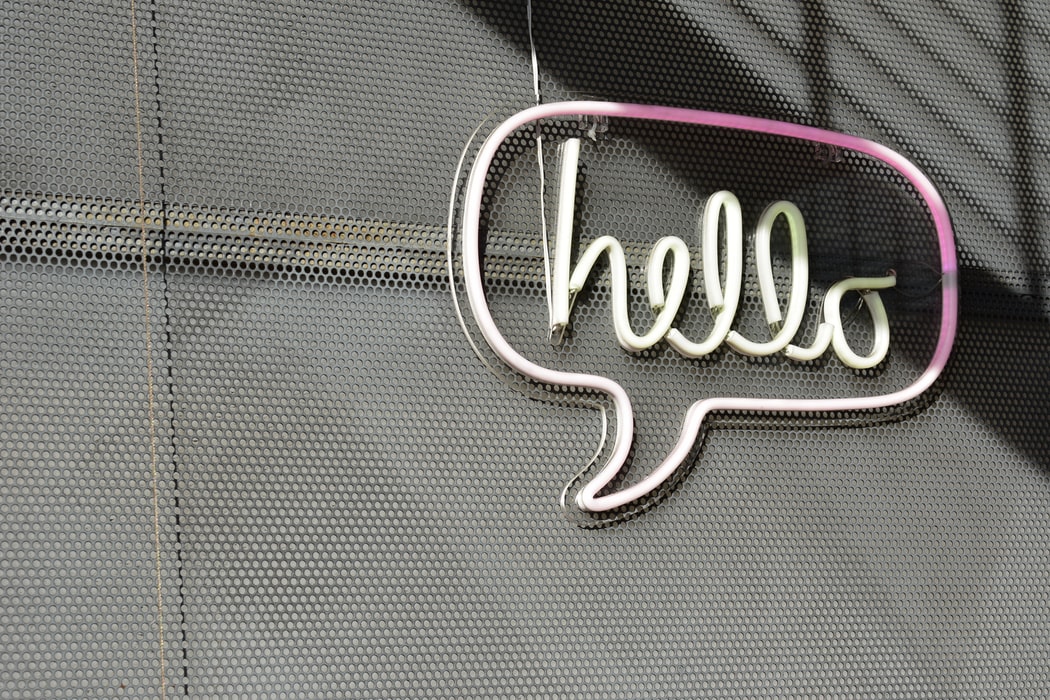
There's a moment of high drama when you give a speech or presentation—and it occurs before you've even said a word. It's the first few seconds when the "curtain" goes up.
In other words, it's all about anticipation. Your audience at that instant is paying maximum attention . . . they're primed for whatever they're about to experience. Often, these audience members will have no idea of your speaking ability. Oh, they may know they're interested in the topic. But they are almost surely filled with hope that the next half-hour or hour will be interesting and exciting.
Great speakers understand how to engage and move audiences at moments like this. You should too! Learn how in my Free Guide , "Six Rules of Effective Public Speaking."
What happens in the next 60 seconds will help determine whether your speech is successful or not. So here are four key elements you should always include in your speech's introduction. If you want listeners to pay attention, become intrigued, and tell themselves they're in good company, do these four things, in the following order:

1) Grab 'Em from the Moment You Begin Speaking
Consider how most presenters begin. Nearly always, it's along the lines of, "Good afternoon. It's so nice to see you all. Today I'll be talking about . ." followed by a slide with the word "Agenda" and 5 bullet points. If we can't hear you screaming as an audience member, it's probably only because you're too polite to be doing it in public.
These first few seconds are such valuable real estate, it's shocking that speakers don't spend any time working up an inviting treatment. In fact, it's not overstating things to say that if you want to succeed as a speaker, you have to know how to start a speech . There are rhetorical devices ready and waiting for you to use to kick off in a much more interesting way. Here for instance are 12 foolproof ways to open a speech .
It's not good enough to take three or four minutes to settle into your groove. Remember that moment of drama, and how everyone is anticipating what you're about to reveal. You need to burn rubber as soon as your tires hit the road, not spin them unnecessarily in the gravel. It's infinitely easier to keep an audience with you if you engage them from the start.
This is the time your natural talent is on display! To build credibility and earn trust, download my Free e-book , "12 Easy Ways to Achieve Presence and Charisma."

2) Reveal Your Topic (and Make It Sound Interesting)
At this point, without going any further into your speech, reveal your topic.
You may be thinking, "Well, yeah, of course!" Yet haven't you sat through speeches where, five minutes in, you're saying to yourself, "What's the topic here, anyway?" It one of the ways we as speakers may take things for granted, believing that the subject matter is perfectly obvious. (The phrase 'perfectly obvious' should not be part of your public speaking thought process!)
Even if the topic of your speech is emblazoned on posters and flyers beforehand, you lose nothing by reminding the audience about it in your intro. Besides, this is an opportunity to make it sound interesting. You could say, "My topic today is migrating birds of the Northeast." OR you could offer this instead: "Today, you'll be meeting some of the most eccentric characters you could ever run into . . . who just happen to be sitting outside your window right now."
Which talk sounds more interesting?
Just be sure to use language that helps rather than hurts your cause. Learn more in my Free White Paper , "25 Words or Phrases to Avoid in Speeches and Presentations."

3) Tell Them Why They Need to Listen
Here's the most neglected family member of speech introductions—the relative too many speakers kept hidden away in the attic, never to see the light of day. It's the moment you tell everyone why your topic is something they really need to pay attention to.
This is a huge part of engaging audiences and getting them to be present. And as I say, many presenters never even give it a thought. But consider this: every member of your audience is in a "What's-in-it-for-me" frame of mind every time they listen to a speech. They're wondering if this is going to be worth their presence and the effort it took to get here (and the time it's taking them away from their work.)
If you answer those questions in a way that relates to their lives and makes the payoff to them clear, they will pay attention. "I want to talk about this with you today, because it's going to make your life much easier," is a great way, for instance, to address a new procedure that everyone in the department would otherwise be bored to death to hear about. So tell them specifically what's in it for them. Believe me, their ears will perk up.

4) Give Them a Roadmap of Your Journey Together
So let's review. You've hooked your listeners' attention, made your topic sound intriguing, and told them how it's going to improve their lives. You're ready for the final part of your introduction: giving them a roadmap of where you'll be going together.
Call it a blueprint if you like that metaphor. (I prefer roadmap because it presupposes that you will be providing signposts along the way.) Partly, this is a way to make your subject manageable. Whatever that subject is, it's too big to talk about in its entirety. So you have to clue listeners in to the sub-topic areas you'll be addressing in this speech. It may sound something like this:
"I'll be talking about three specific elements of [reaching this goal, gaining this proficiency, understanding what you're looking at, etc.]. First, we'll examine [your first main point]. Once we have that information, we'll be able to [discuss your second item]. Finally, we'll add the third ingredient which will [give us a functioning model, repair the breach, head off the problem in the future . . . whatever the particulars are in your talk]." To me, this is already sounding more interesting than: "Here are the five parts of today's agenda for this speech."
As the great salesman Dale Carnegie once advised (and as I wrote about here ): "Tell the audience what you're going to say, say it; then tell them what you've said." To translate that into today's public speaking: Entice them with the journey you'll be going on together, take them there; then remind them of what an enlightening trip it's been.
You should follow me on Twitter here .
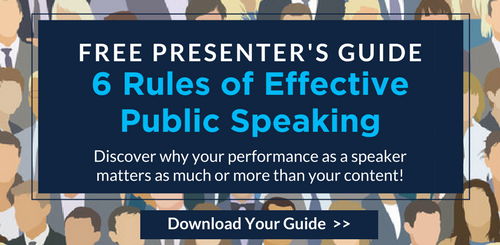
Gary Genard is an actor, author, and expert in theater-based public speaking training. His company, Boston-based The Genard Method offers in-person and online training to help executives and teams become extraordinary communicators. In 2020 for the seventh consecutive year, Gary has been ranked by Global Gurus as One of The World's Top 30 Communication Professionals . He is the author of How to Give a Speech . His second book, Fearless Speaking , was recently named as " One of the 100 Best Confidence Books of All Time ." Contact Gary here .
Tags: public speaking training , presentation skills , public speaking , public speaking tips , how to start a speech , video conferencing , sales training , speech introduction , presence , leadership , keynote speaker , online meetings , how to write a speech , motivational speaker , public speaker , leadership training , audiences , keynote speaker training , how to start a presentation , motivational speaker training , sales , online coaching , Zoom , online classes , online learning , online training , speaking tips , zoom meetings , virtual meetings , videoconferencing , video conferences , introduction , how to write an introduction
Subscribe to Email Updates
Subscribe to the blog, follow gary genard.
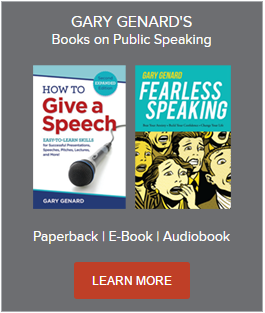
- Training Techniques
Main Office - Boston
[email protected] 617-993-3410
- Executive Presentation Skills
- Rehearsal & Preparation
- Group Presentation Skills
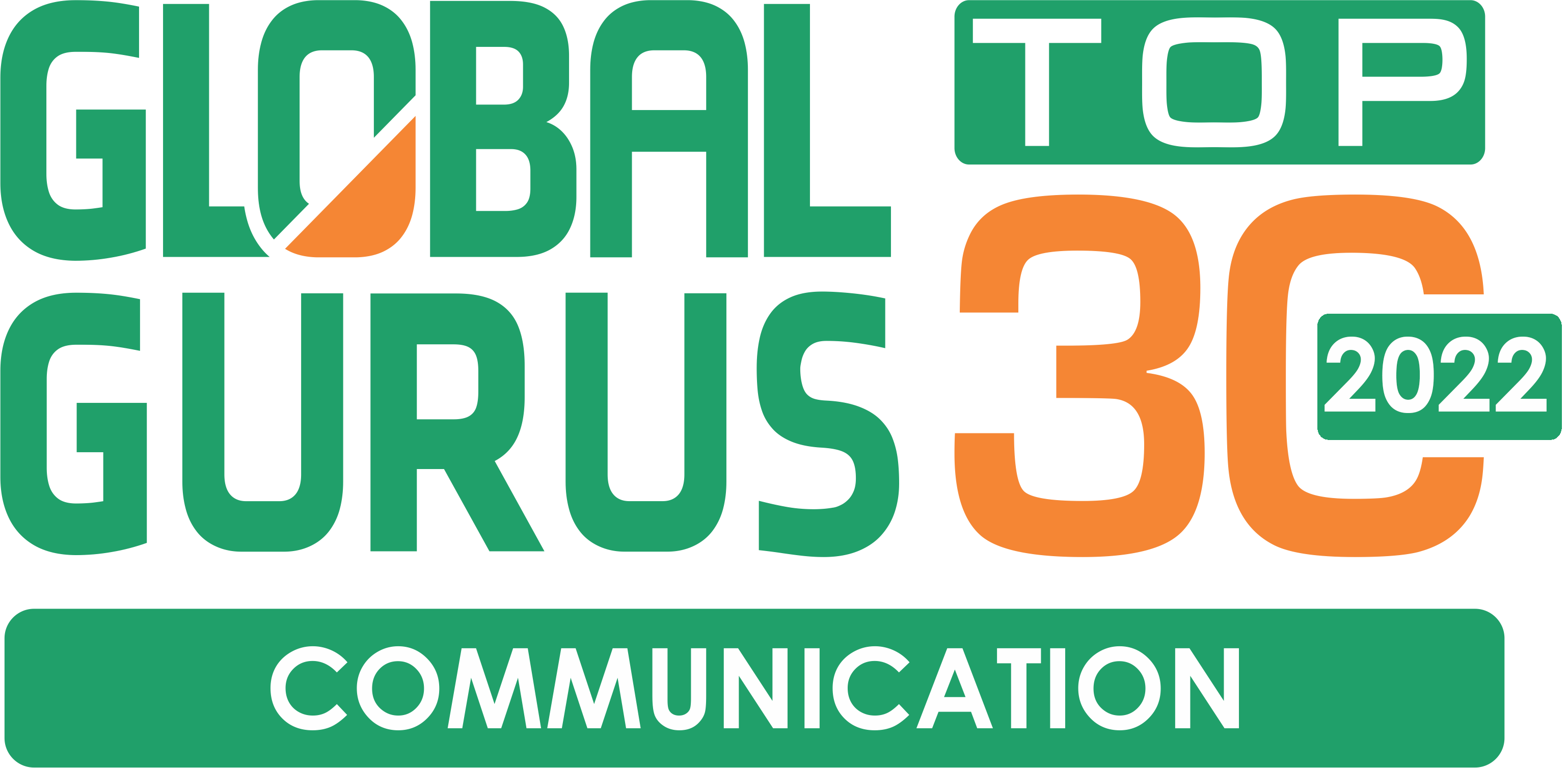
Speeches HQ
15 Introduction Speech Attention Getters
Those first few words can turn a regular speech into something special. Starting strong helps grab your audience’s attention and keeps them interested throughout your message. Great openings make people want to hear more.
Speaking at a wedding, conference, or graduation requires a strong start that connects you with your listeners. A powerful introduction builds trust and engagement from the beginning. Here are proven ways to start your speech that will keep your audience interested from start to finish.

Introduction Speech Attention Getters
These carefully selected speech openings show different ways to capture audience attention from your first word.
1. The Personal Story Opener
“My grandmother used to say that life gives you exactly what you need, exactly when you need it. Standing here today, those words ring especially true. You see, twenty years ago, I sat right where you are now, filled with the same mix of excitement and uncertainty about what lay ahead. That day shaped everything that followed, and here’s why…”
— END OF INTRO —
Commentary: A warm, relatable opening that connects through shared experience. Perfect for graduation speeches, motivational talks, or career-focused presentations.
2. The Striking Statistic
“Every sixty seconds, five thousand people log into social media for the first time. That’s three hundred thousand new users every hour. Each one hoping to connect, to belong, to find their place online. But what happens next might surprise you…”
Commentary: An eye-opening statistical opener that grabs attention immediately. Works well for business presentations, tech conferences, or social impact discussions.
3. The Question Series
“Do you notice how quiet your neighborhood has become? Where are the sounds of children playing outside? Why do parks sit empty on sunny days? Something’s changing in our communities, and we can bring back the active street life we used to know…”
Commentary: A thought-provoking series of questions that builds curiosity and concern. Excellent for community meetings, urban planning presentations, or social advocacy speeches.
4. The Strong Statement
“Success shows clear patterns. Behind each breakthrough, each innovation, each milestone reached, you’ll find steps anyone can follow. Here’s how Sarah used these steps to build a million-dollar company from her garage…”
Commentary: A confident opening that shows value ahead. Great for business seminars, entrepreneurship talks, or success-oriented presentations.
5. The Time Machine
“December 14th, 1903. Two brothers stood on a windy beach in North Carolina, about to change transportation forever. They had no fancy degrees. No big financial backing. Just complete belief that humans could fly. Their story shows us something powerful about staying determined…”
Commentary: A compelling historical reference that connects to current challenges. Ideal for innovation talks, engineering presentations, or motivational speeches.
6. The Compare and Connect
“Right now, a tech specialist in California codes the next big app. At the same time, a young girl in Kenya solves her community’s water shortage with a simple, smart invention. Both are changing lives, each in their own way…”
Commentary: An engaging comparison that shifts expectations and opens minds. Perfect for development talks, innovation conferences, or social entrepreneurship events.
7. The Morning Moment
“The sun peeks through your window. Coffee fills your kitchen with its smell. You check your phone messages and suddenly – everything changes. That’s what happened to Mike Stevens, and his story will change how you see opportunity…”
Commentary: A rich, detailed opening that pulls listeners into the story. Excellent for motivational speeches, sales presentations, or personal development seminars.
8. The Shared Challenge
“Stress takes away our joy, blocks our creativity, and stops us from reaching our goals. But there’s another way forward. A path leading to peace, purpose, and lasting happiness…”
Commentary: An opening that points out common problems and hints at solutions. Works well for wellness seminars, mental health talks, or professional development workshops.
9. The Tomorrow View
“Soon, cars will drive themselves. Buildings will clean the air. Robots might serve your morning coffee. But the biggest changes won’t come from machines. They’ll show up in how we connect, create, and care for each other…”
Commentary: A forward-looking opener that starts discussion. Perfect for technology conferences, trend presentations, or innovation summits.
10. The Reset Button
“Take a deep breath. Feel your feet on the ground. Look at the people around you. This moment could start something amazing. Here’s why…”
Commentary: A mindful opening that creates focus and attention. Ideal for personal growth workshops, meditation seminars, or mindfulness training.
11. The Big Question
“What could you do with three extra hours each day? How would your life look with more time for what matters most? Here are secrets from people who found their answer…”
Commentary: An engaging opener that offers possibilities. Great for productivity workshops, time management seminars, or life optimization presentations.
12. The Fresh Look
“‘Money can’t buy happiness.’ You’ve heard this before. But new studies show something different. The amount matters less than how you spend it. This changes the whole discussion…”
Commentary: A new view of common wisdom that makes people think differently. Fits well in financial seminars, happiness research presentations, or consumer psychology talks.
13. The Connected Stories
“Meet Sarah from New York and Michael from Tokyo. Their paths cross in an amazing way. But first, let’s see how their story started…”
Commentary: An interesting story structure that builds excitement. Perfect for keynote speeches, storytelling workshops, or cultural exchange presentations.
14. The Time Focus
“Three seconds. That’s how long it takes to make a first impression. Three seconds to gain trust or lose it. Three seconds to start something big or miss your chance…”
Commentary: A sharp, rhythmic opening that shows importance through repetition. Excellent for leadership talks, sales training, or personal branding presentations.
15. The Common Ground
“That feeling hits you. You stand at a turning point. A choice needs making. You wonder if you’re ready. This story shows how one choice can start good things happening…”
Commentary: A relatable opening that connects right away. Works well for life coaching sessions, career transition talks, or personal change workshops.
These openers show different ways to grab attention and connect with your audience immediately. Each method fits specific needs and can match your style and event. Pick one that fits your message and audience, then make it yours.

Make A Speech Introduction That Grabs Audience Attention
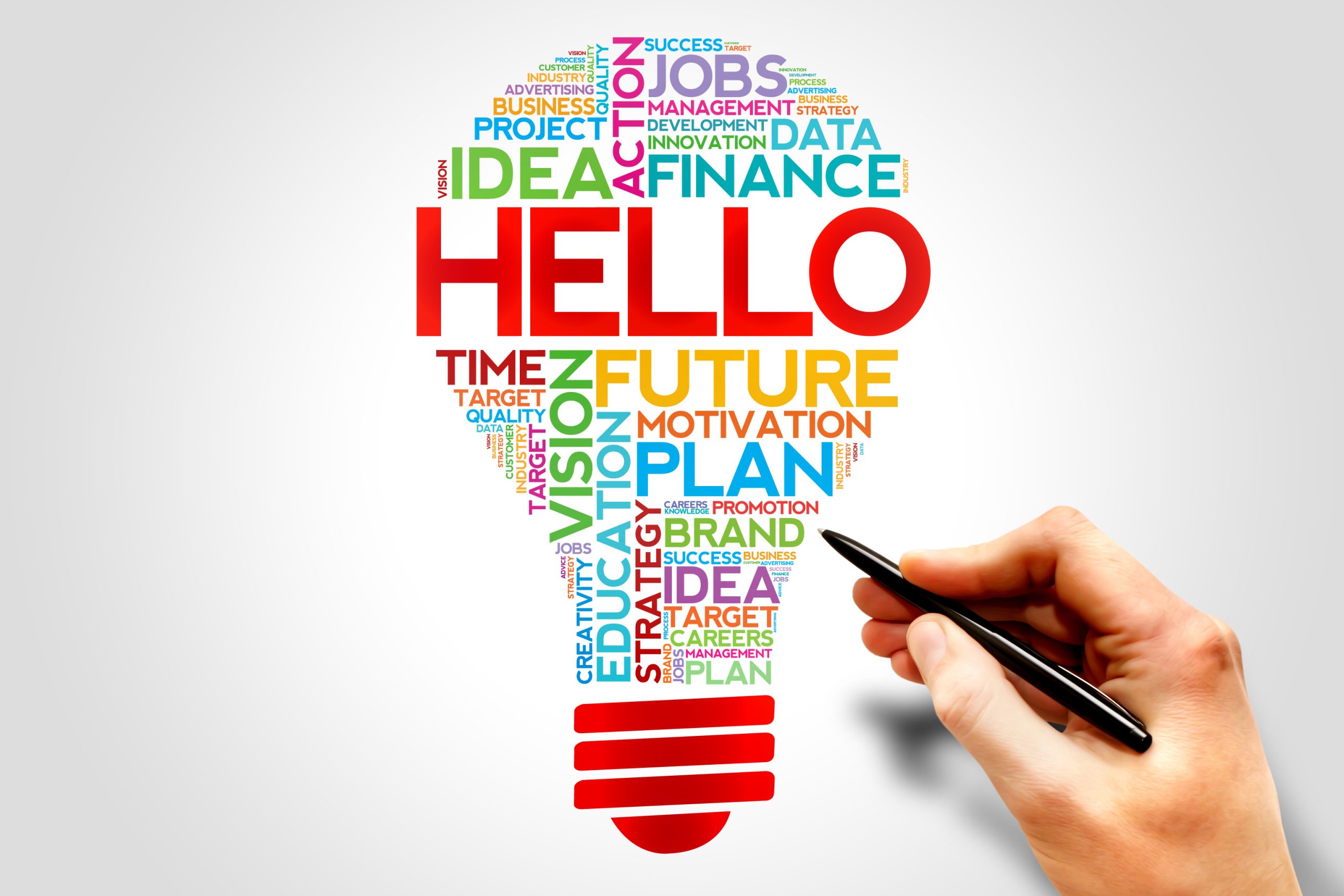
The speech introduction is the first part of a speech and the first opportunity to grab the audience’s attention. The speaker should state the topic, make it relatable to the audience, establish credibility and preview the main points. You should write or finalize your introduction at the end so that it reflects what you actually said.
Listen up, audience!
No matter whether you are giving an informative speech to enlighten an audience about a certain topic or a persuasive speech aims to convince the crowd to adopt a particular viewpoint. But whichever type of speech you’re writing or delivering, one thing is true: You must create an attention-grabbing speech introduction.
Table of Contents
What Is The Best Way To Start A Speech?
Whether in speech writing or public speaking, the role of a good intro cannot be understated. It is your best chance to captivate your audience’s attention and entice them to be with you until the rest of your speech.
It’s also your opportunity to introduce the topic and thesis statement and set up the points you’ll discuss later. So, keep in mind that you emphasize the relevance of your subject matter to the audience and contextualize it properly.
These are some of the best ways to make a compelling introduction speech.
- State a quote or use a historical event reference. Analyze your target audience and look for a powerful quote from a relevant figure or a historical event that will resonate with listeners and relate it to your topic. A notable quotation can immediately establish a strong connection. On the other hand, an important event will help you illustrate your point or paint a scenario better.
- Share a personal story. Sometimes, you don’t have to search far and wide to demonstrate a point. You can tap into your personal experience and share something about yourself. Generally, audience members enjoy hearing stories as they pique their interest and get a glimpse of who the speaker is. Your anecdotes will also make you more human and accessible.
- Start with an “Imagine” or “What if?” scenario. Want to make your audience engaged? Let their imagination run. In many speeches over the years, some of the most successful ones used this technique. Speakers transport the audience to the future or a scenario wherein their proposed idea or belief reigns. For example, “What if we live in a world where everyone can access healthcare?”
- Count on a video or any other visual aids. If you’re a public speaker keen to use technology, you may also want to commence your speech with visual aids. For instance, you can show a pre-prepared video to draw the crowd’s attention right before you speak. If you’re talking about hunger and food security, you can show footage of how such issues take a toll in many third-world countries.
- Tell surprising statistics. One of the most effective ways to shock — and, ultimately, grab your audience’s attention is by telling real, hard facts. If you’re looking for a good attention-getter, you can rely on surprising statistics about your topic. For instance, if your topic is bullying, you can mention that in the US, around 3 million students are victims of bullying.
- Ask the audience a question. Another way to hook your audience is by asking them a question. It can be a direct one (e.g., “Who among here are…” then ask for a show of hands). It can also be a rhetorical question (e.g., “What is the meaning of life?”). The key is interacting with the crowd to get their attention and effectively introducing your subject matter.

What Should You Include In the Introduction?
When you look at intro samples and templates on the web, you’ll find that effective speech introductions contain key elements. And one of the most important is your attention-grabber, which will compel your audience to listen to your speech and narrative.
You must also introduce your speech topic and indicate why it matters to your audience. You should also share something about yourself, especially your credibility, to discuss a particular subject matter.
Once you’ve laid out these foundations, state your central idea or thesis statement. Tell the audience members the point of view you want them to adopt, and give them a preview of the main points you’re discussing if you’re giving a persuasive speech. If you’re writing or delivering an informative one, you can provide them with a brief speech outline or the key points you’ll touch upon throughout the body of the speech.
What Are The Best Lines To Introduce A Speech?
One of the most common public speaking tips you’ll encounter is to have a good introduction. To help you capture the audience’s attention, here are some ideas you can use in your speech.
- A famous quote (For example, “Innovation distinguishes between a leader and a follower” by Steve Jobs)
- A song lyric (“Imagine there’s no countries/ It isn’t hard to do/ Nothing to kill or die for/ And no religion, too,” from “Imagine by John Lennon)
- A line from a poem (“You may write me down in history With your bitter, twisted lies, You may trod me in the very dirt But still, like dust, I’ll rise,” from “Still I Rise” by Maya Angelou)
- A line from a movie (“Greed, for a lack of a better word, is good,” from “Wall Street”)
- Reference to a historical event (“Two hundred years ago, one of the most important proclamations was made. Through the Emancipation Proclamation issued by President Abraham Lincoln, the enslaved Black people were given freedom.”
- Reference to a notable figure (“Stan Lee, the man behind iconic Marvel characters, was hired as an editorial assistant at a comics company after graduating high school.”).
- A bold statement (“Prostitution must be legalized.”)
- A serious statement (“Climate change is a pressing issue.”)
- A humorous line (“Don’t underestimate me. That’s the job of my mom.”)
- A shocking statistic (“If you’re consuming too much fast food and baked goods, did you know that you are 51% more likely to be depressed?”)
- A direct question (“Who among here plays violent video games?”)
- A rhetorical question (“Is there a more powerful feeling than love?”)
- A personal story (“Back when I was a fresh college graduate, I busied myself applying to the top multi-national companies.”)
- An anecdote (“Long ago, there was a man — an old but healthy man — who dared climb Mount Everest. He was 80, and he succeeded.”)
- A what-if scenario (“What if there were no poor people?”)
How Do You Introduce Yourself In A Speech?
Whether you’re a first-time speaker or a veteran, how you approach introducing yourself in a speech is important in establishing your credibility. To avoid getting called boring, you might want to shy away from the usual “Hi, everyone. I’m (your name). I (your credentials), and today I will be talking about (points of the speech).”
Usually, someone else may have given your name and background. This gives you the liberty to begin your speech more interestingly.
You can start by stating any of the introduction lines listed above, then transition to why listening to you will matter to them. For example, if you’re talking about mental health and depression, you can follow up a surprising statistic with something like, “I know because I was a part of that statistic. Now, I’ve studied to become a therapist myself.”
To further create an air of authority, you must be mindful of your body language (taking a deep breath before speaking can help you shake off your nervousness and tension). Additionally, you must make eye contact and speak words clearly.
How Do You Introduce A Speaker?
Now, if you’re tasked to introduce the one who will deliver the speech, it’s your responsibility to set the right atmosphere and build excitement.
One of the first things to do is know how to pronounce the speaker’s name and ensure that what you’ll say about the speaker’s credibility is factual. Since you’re only introducing the speaker, keep things simple and concise. If you want to enrich your introduction, you can ask the speaker what they want to be highlighted (Do they have a new book? Which prestigious groups are they affiliated with?).
Like what the speaker would do, you must also make eye contact to engage the audience. Practice and have a run-through before you take the stage to guarantee a smooth delivery.

What Is An Example Of A Speech Introduction?
Speakers and speech writers know how challenging it is to grab an audience’s attention. Here’s a good example of an introductory speech that uses statistics. This is from English restaurateur Jamie Oliver who delivered a TED Talk about food:
“Sadly, in the next 18 minutes when I do our chat, four Americans that are alive will be dead from the food that they eat.
My name’s Jamie Oliver. I’m 34 years old. I’m from Essex in England, and for the last seven years, I’ve worked fairly tirelessly to save lives in my own way. I’m not a doctor; I’m a chef, I don’t have expensive equipment or medicine. I use information, education.”
What Is The Introduction For A Speech On Bully
Looking for inspiration for a good introduction where your topic is bullying? Check out this sample intro from actress and UNICEF Goodwill Ambassador Millie Bobby Brown during World Children’s Day in 2019:
“In world capitals — in buildings like this — adults talk about children’s rights. But today, young people don’t want to be talked about. They want to do the talking.
Millions of people responded to UNICEF surveys and petitions about what the Convention on the Rights of the Child meant to them. In the words of one young person: ‘Be an active voice. Don’t let things go unnoticed. So today, I want to talk about an issue that is very personal to me. Something that so often goes unnoticed — but causes real suffering. Bullying.”
What Are Some Other Examples Of Speech Introductions?
Below are some more speech introduction examples you can take inspiration from.
- “Three things I learned while my plane crashed” by Ric Elias : “Imagine a big explosion as you climb through 3,000 ft. Imagine a plane full of smoke. Imagine an engine going clack, clack, clack, clack, clack, clack, clack. It sounds scary. Well, I had a unique seat that day. I was sitting in 1D.”
- “How to find and do work you love” by Scott Dinsmore : “8 years ago, I got the worst career advice of my life.”
“How great leaders inspire action” by Simon Sinek : “How do you explain when things don’t go as we assume? Or better, how do you explain when others are able to achieve things that seem to defy all of the assumptions?”
Recent Posts
Active Listening Absorbs The Whole Message, Not Just The Words
Active listening goes beyond hearing the words someone is saying to you and understanding the message they are conveying. Many only hear a small percentage of what is being said as they are...
Counteracting Fear Of Public Speaking With Coaching And Therapy
Nearly 75% of people experience the social phobia of fear of public speaking. The result may be nervousness before speaking or a full-blown panic attack. Practicing public speaking may lessen the...

Want to create or adapt books like this? Learn more about how Pressbooks supports open publishing practices.
9.3 Putting It Together: Steps to Complete Your Introduction
Learning objectives.
- Clearly identify why an audience should listen to a speaker.
- Discuss how you can build your credibility during a speech.
- Understand how to write a clear thesis statement.
- Design an effective preview of your speech’s content for your audience.

Erin Brown-John – puzzle – CC BY-NC 2.0.
Once you have captured your audience’s attention, it’s important to make the rest of your introduction interesting, and use it to lay out the rest of the speech. In this section, we are going to explore the five remaining parts of an effective introduction: linking to your topic, reasons to listen, stating credibility, thesis statement, and preview.
Link to Topic
After the attention-getter, the second major part of an introduction is called the link to topic. The link to topic is the shortest part of an introduction and occurs when a speaker demonstrates how an attention-getting device relates to the topic of a speech. Often the attention-getter and the link to topic are very clear. For example, if you look at the attention-getting device example under historical reference above, you’ll see that the first sentence brings up the history of the Vietnam War and then shows us how that war can help us understand the Iraq War. In this case, the attention-getter clearly flows directly to the topic. However, some attention-getters need further explanation to get to the topic of the speech. For example, both of the anecdote examples (the girl falling into the manhole while texting and the boy and the filberts) need further explanation to connect clearly to the speech topic (i.e., problems of multitasking in today’s society).
Let’s look at the first anecdote example to demonstrate how we could go from the attention-getter to the topic.
In July 2009, a high school girl named Alexa Longueira was walking along a main boulevard near her home on Staten Island, New York, typing in a message on her cell phone. Not paying attention to the world around her, she took a step and fell right into an open manhole. This anecdote illustrates the problem that many people are facing in today’s world. We are so wired into our technology that we forget to see what’s going on around us—like a big hole in front of us.
In this example, the third sentence here explains that the attention-getter was an anecdote that illustrates a real issue. The fourth sentence then introduces the actual topic of the speech.
Let’s now examine how we can make the transition from the parable or fable attention-getter to the topic:
The ancient Greek writer Aesop told a fable about a boy who put his hand into a pitcher of filberts. The boy grabbed as many of the delicious nuts as he possibly could. But when he tried to pull them out, his hand wouldn’t fit through the neck of the pitcher because he was grasping so many filberts. Instead of dropping some of them so that his hand would fit, he burst into tears and cried about his predicament. The moral of the story? “Don’t try to do too much at once.” In today’s world, many of us are us are just like the boy putting his hand into the pitcher. We are constantly trying to grab so much or do so much that it prevents us from accomplishing our goals. I would like to show you three simple techniques to manage your time so that you don’t try to pull too many filberts from your pitcher.
In this example, we added three new sentences to the attention-getter to connect it to the speech topic.
Reasons to Listen
Once you have linked an attention-getter to the topic of your speech, you need to explain to your audience why your topic is important. We call this the “why should I care?” part of your speech because it tells your audience why the topic is directly important to them. Sometimes you can include the significance of your topic in the same sentence as your link to the topic, but other times you may need to spell out in one or two sentences why your specific topic is important.
People in today’s world are very busy, and they do not like their time wasted. Nothing is worse than having to sit through a speech that has nothing to do with you. Imagine sitting through a speech about a new software package you don’t own and you will never hear of again. How would you react to the speaker? Most of us would be pretty annoyed at having had our time wasted in this way. Obviously, this particular speaker didn’t do a great job of analyzing her or his audience if the audience isn’t going to use the software package—but even when speaking on a topic that is highly relevant to the audience, speakers often totally forget to explain how and why it is important.
Appearing Credible
The next part of a speech is not so much a specific “part” as an important characteristic that needs to be pervasive throughout your introduction and your entire speech. As a speaker, you want to be seen as credible (competent, trustworthy, and caring/having goodwill). As mentioned earlier in this chapter, credibility is ultimately a perception that is made by your audience. While your audience determines whether they perceive you as competent, trustworthy, and caring/having goodwill, there are some strategies you can employ to make yourself appear more credible.
First, to make yourself appear competent, you can either clearly explain to your audience why you are competent about a given subject or demonstrate your competence by showing that you have thoroughly researched a topic by including relevant references within your introduction. The first method of demonstrating competence—saying it directly—is only effective if you are actually a competent person on a given subject. If you are an undergraduate student and you are delivering a speech about the importance of string theory in physics, unless you are a prodigy of some kind, you are probably not a recognized expert on the subject. Conversely, if your number one hobby in life is collecting memorabilia about the Three Stooges, then you may be an expert about the Three Stooges. However, you would need to explain to your audience your passion for collecting Three Stooges memorabilia and how this has made you an expert on the topic.
If, on the other hand, you are not actually a recognized expert on a topic, you need to demonstrate that you have done your homework to become more knowledgeable than your audience about your topic. The easiest way to demonstrate your competence is through the use of appropriate references from leading thinkers and researchers on your topic. When you demonstrate to your audience that you have done your homework, they are more likely to view you as competent.
The second characteristic of credibility, trustworthiness, is a little more complicated than competence, for it ultimately relies on audience perceptions. One way to increase the likelihood that a speaker will be perceived as trustworthy is to use reputable sources. If you’re quoting Dr. John Smith, you need to explain who Dr. John Smith is so your audience will see the quotation as being more trustworthy. As speakers we can easily manipulate our sources into appearing more credible than they actually are, which would be unethical. When you are honest about your sources with your audience, they will trust you and your information more so than when you are ambiguous. The worst thing you can do is to out-and-out lie about information during your speech. Not only is lying highly unethical, but if you are caught lying, your audience will deem you untrustworthy and perceive everything you are saying as untrustworthy. Many speakers have attempted to lie to an audience because it will serve their own purposes or even because they believe their message is in their audience’s best interest, but lying is one of the fastest ways to turn off an audience and get them to distrust both the speaker and the message.
The third characteristic of credibility to establish during the introduction is the sense of caring/goodwill. While some unethical speakers can attempt to manipulate an audience’s perception that the speaker cares, ethical speakers truly do care about their audiences and have their audience’s best interests in mind while speaking. Often speakers must speak in front of audiences that may be hostile toward the speaker’s message. In these cases, it is very important for the speaker to explain that he or she really does believe her or his message is in the audience’s best interest. One way to show that you have your audience’s best interests in mind is to acknowledge disagreement from the start:
Today I’m going to talk about why I believe we should enforce stricter immigration laws in the United States. I realize that many of you will disagree with me on this topic. I used to believe that open immigration was a necessity for the United States to survive and thrive, but after researching this topic, I’ve changed my mind. While I may not change all of your minds today, I do ask that you listen with an open mind, set your personal feelings on this topic aside, and judge my arguments on their merits.
While clearly not all audience members will be open or receptive to opening their minds and listening to your arguments, by establishing that there is known disagreement, you are telling the audience that you understand their possible views and are not trying to attack their intellect or their opinions.
Thesis Statement
A thesis statement is a short, declarative sentence that states the purpose, intent, or main idea of a speech. A strong, clear thesis statement is very valuable within an introduction because it lays out the basic goal of the entire speech. We strongly believe that it is worthwhile to invest some time in framing and writing a good thesis statement. You may even want to write your thesis statement before you even begin conducting research for your speech. While you may end up rewriting your thesis statement later, having a clear idea of your purpose, intent, or main idea before you start searching for research will help you focus on the most appropriate material. To help us understand thesis statements, we will first explore their basic functions and then discuss how to write a thesis statement.
Basic Functions of a Thesis Statement
A thesis statement helps your audience by letting them know “in a nutshell” what you are going to talk about. With a good thesis statement you will fulfill four basic functions: you express your specific purpose, provide a way to organize your main points, make your research more effective, and enhance your delivery.
Express Your Specific Purpose
To orient your audience, you need to be as clear as possible about your meaning. A strong thesis will prepare your audience effectively for the points that will follow. Here are two examples:
- “Today, I want to discuss academic cheating.” (weak example)
- “Today, I will clarify exactly what plagiarism is and give examples of its different types so that you can see how it leads to a loss of creative learning interaction.” (strong example)
The weak statement will probably give the impression that you have no clear position about your topic because you haven’t said what that position is. Additionally, the term “academic cheating” can refer to many behaviors—acquiring test questions ahead of time, copying answers, changing grades, or allowing others to do your coursework—so the specific topic of the speech is still not clear to the audience.
The strong statement not only specifies plagiarism but also states your specific concern (loss of creative learning interaction).
Provide a Way to Organize Your Main Points
A thesis statement should appear, almost verbatim, toward the end of the introduction to a speech. A thesis statement helps the audience get ready to listen to the arrangement of points that follow. Many speakers say that if they can create a strong thesis sentence, the rest of the speech tends to develop with relative ease. On the other hand, when the thesis statement is not very clear, creating a speech is an uphill battle.
When your thesis statement is sufficiently clear and decisive, you will know where you stand about your topic and where you intend to go with your speech. Having a clear thesis statement is especially important if you know a great deal about your topic or you have strong feelings about it. If this is the case for you, you need to know exactly what you are planning on talking about in order to fit within specified time limitations. Knowing where you are and where you are going is the entire point in establishing a thesis statement; it makes your speech much easier to prepare and to present.
Let’s say you have a fairly strong thesis statement, and that you’ve already brainstormed a list of information that you know about the topic. Chances are your list is too long and has no focus. Using your thesis statement, you can select only the information that (1) is directly related to the thesis and (2) can be arranged in a sequence that will make sense to the audience and will support the thesis. In essence, a strong thesis statement helps you keep useful information and weed out less useful information.
Make Your Research More Effective
If you begin your research with only a general topic in mind, you run the risk of spending hours reading mountains of excellent literature about your topic. However, mountains of literature do not always make coherent speeches. You may have little or no idea of how to tie your research all together, or even whether you should tie it together. If, on the other hand, you conduct your research with a clear thesis statement in mind, you will be better able to zero in only on material that directly relates to your chosen thesis statement. Let’s look at an example that illustrates this point:
Many traffic accidents involve drivers older than fifty-five.
While this statement may be true, you could find industrial, medical, insurance literature that can drone on ad infinitum about the details of all such accidents in just one year. Instead, focusing your thesis statement will help you narrow the scope of information you will be searching for while gathering information. Here’s an example of a more focused thesis statement:
Three factors contribute to most accidents involving drivers over fifty-five years of age: failing eyesight, slower reflexes, and rapidly changing traffic conditions.
This framing is somewhat better. This thesis statement at least provides three possible main points and some keywords for your electronic catalog search. However, if you want your audience to understand the context of older people at the wheel, consider something like:
Mature drivers over fifty-five years of age must cope with more challenging driving conditions than existed only one generation ago: more traffic moving at higher speeds, the increased imperative for quick driving decisions, and rapidly changing ramp and cloverleaf systems. Because of these challenges, I want my audience to believe that drivers over the age of sixty-five should be required to pass a driving test every five years.
This framing of the thesis provides some interesting choices. First, several terms need to be defined, and these definitions might function surprisingly well in setting the tone of the speech. Your definitions of words like “generation,” “quick driving decisions,” and “cloverleaf systems” could jolt your audience out of assumptions they have taken for granted as truth.
Second, the framing of the thesis provides you with a way to describe the specific changes as they have occurred between, say, 1970 and 2010. How much, and in what ways, have the volume and speed of traffic changed? Why are quick decisions more critical now? What is a “cloverleaf,” and how does any driver deal cognitively with exiting in the direction seemingly opposite to the desired one? Questions like this, suggested by your own thesis statement, can lead to a strong, memorable speech.
Enhance Your Delivery
When your thesis is not clear to you, your listeners will be even more clueless than you are—but if you have a good clear thesis statement, your speech becomes clear to your listeners. When you stand in front of your audience presenting your introduction, you can vocally emphasize the essence of your speech, expressed as your thesis statement. Many speakers pause for a half second, lower their vocal pitch slightly, slow down a little, and deliberately present the thesis statement, the one sentence that encapsulates its purpose. When this is done effectively, the purpose, intent, or main idea of a speech is driven home for an audience.
How to Write a Thesis Statement
Now that we’ve looked at why a thesis statement is crucial in a speech, let’s switch gears and talk about how we go about writing a solid thesis statement. A thesis statement is related to the general and specific purposes of a speech as we discussed them in Chapter 6 “Finding a Purpose and Selecting a Topic” .
Choose Your Topic
The first step in writing a good thesis statement was originally discussed in Chapter 6 “Finding a Purpose and Selecting a Topic” when we discussed how to find topics. Once you have a general topic, you are ready to go to the second step of creating a thesis statement.
Narrow Your Topic
One of the hardest parts of writing a thesis statement is narrowing a speech from a broad topic to one that can be easily covered during a five- to ten-minute speech. While five to ten minutes may sound like a long time to new public speakers, the time flies by very quickly when you are speaking. You can easily run out of time if your topic is too broad. To ascertain if your topic is narrow enough for a specific time frame, ask yourself three questions.
First, is your thesis statement narrow or is it a broad overgeneralization of a topic? An overgeneralization occurs when we classify everyone in a specific group as having a specific characteristic. For example, a speaker’s thesis statement that “all members of the National Council of La Raza are militant” is an overgeneralization of all members of the organization. Furthermore, a speaker would have to correctly demonstrate that all members of the organization are militant for the thesis statement to be proven, which is a very difficult task since the National Council of La Raza consists of millions of Hispanic Americans. A more appropriate thesis related to this topic could be, “Since the creation of the National Council of La Raza [NCLR] in 1968, the NCLR has become increasingly militant in addressing the causes of Hispanics in the United States.”
The second question to ask yourself when narrowing a topic is whether your speech’s topic is one clear topic or multiple topics. A strong thesis statement consists of only a single topic. The following is an example of a thesis statement that contains too many topics: “Medical marijuana, prostitution, and gay marriage should all be legalized in the United States.” Not only are all three fairly broad, but you also have three completely unrelated topics thrown into a single thesis statement. Instead of a thesis statement that has multiple topics, limit yourself to only one topic. Here’s an example of a thesis statement examining only one topic: “Today we’re going to examine the legalization and regulation of the oldest profession in the state of Nevada.” In this case, we’re focusing our topic to how one state has handled the legalization and regulation of prostitution.
The last question a speaker should ask when making sure a topic is sufficiently narrow is whether the topic has direction. If your basic topic is too broad, you will never have a solid thesis statement or a coherent speech. For example, if you start off with the topic “Barack Obama is a role model for everyone,” what do you mean by this statement? Do you think President Obama is a role model because of his dedication to civic service? Do you think he’s a role model because he’s a good basketball player? Do you think he’s a good role model because he’s an excellent public speaker? When your topic is too broad, almost anything can become part of the topic. This ultimately leads to a lack of direction and coherence within the speech itself. To make a cleaner topic, a speaker needs to narrow her or his topic to one specific area. For example, you may want to examine why President Obama is a good speaker.
Put Your Topic into a Sentence
Once you’ve narrowed your topic to something that is reasonably manageable given the constraints placed on your speech, you can then formalize that topic as a complete sentence. For example, you could turn the topic of President Obama’s public speaking skills into the following sentence: “Because of his unique sense of lyricism and his well-developed presentational skills, President Barack Obama is a modern symbol of the power of public speaking.” Once you have a clear topic sentence, you can start tweaking the thesis statement to help set up the purpose of your speech.
Add Your Argument, Viewpoint, or Opinion
This function only applies if you are giving a speech to persuade. If your topic is informative, your job is to make sure that the thesis statement is nonargumentative and focuses on facts. For example, in the preceding thesis statement we have a couple of opinion-oriented terms that should be avoided for informative speeches: “unique sense,” “well-developed,” and “power.” All three of these terms are laced with an individual’s opinion, which is fine for a persuasive speech but not for an informative speech. For informative speeches, the goal of a thesis statement is to explain what the speech will be informing the audience about, not attempting to add the speaker’s opinion about the speech’s topic. For an informative speech, you could rewrite the thesis statement to read, “This speech is going to analyze Barack Obama’s use of lyricism in his speech, ‘A World That Stands as One,’ delivered July 2008 in Berlin.”
On the other hand, if your topic is persuasive, you want to make sure that your argument, viewpoint, or opinion is clearly indicated within the thesis statement. If you are going to argue that Barack Obama is a great speaker, then you should set up this argument within your thesis statement.
Use the Thesis Checklist
Once you have written a first draft of your thesis statement, you’re probably going to end up revising your thesis statement a number of times prior to delivering your actual speech. A thesis statement is something that is constantly tweaked until the speech is given. As your speech develops, often your thesis will need to be rewritten to whatever direction the speech itself has taken. We often start with a speech going in one direction, and find out through our research that we should have gone in a different direction. When you think you finally have a thesis statement that is good to go for your speech, take a second and make sure it adheres to the criteria shown in Table 9.1 “Thesis Checklist”
Table 9.1 Thesis Checklist
Preview of Speech
The final part of an introduction contains a preview of the major points to be covered within your speech. I’m sure we’ve all seen signs that have three cities listed on them with the mileage to reach each city. This mileage sign is an indication of what is to come. A preview works the same way. A preview foreshadows what the main body points will be in the speech. For example, to preview a speech on bullying in the workplace, one could say, “To understand the nature of bullying in the modern workplace, I will first define what workplace bullying is and the types of bullying, I will then discuss the common characteristics of both workplace bullies and their targets, and lastly, I will explore some possible solutions to workplace bullying.” In this case, each of the phrases mentioned in the preview would be a single distinct point made in the speech itself. In other words, the first major body point in this speech would examine what workplace bullying is and the types of bullying; the second major body point in this speech would discuss the common characteristics of both workplace bullies and their targets; and lastly, the third body point in this speech would explore some possible solutions to workplace bullying.
Key Takeaways
- Linking the attention-getter to the speech topic is essential so that you maintain audience attention and so that the relevance of the attention-getter is clear to your audience.
- Establishing how your speech topic is relevant and important shows the audience why they should listen to your speech.
- To be an effective speaker, you should convey all three components of credibility, competence, trustworthiness, and caring/goodwill, by the content and delivery of your introduction.
- A clear thesis statement is essential to provide structure for a speaker and clarity for an audience.
- An effective preview identifies the specific main points that will be present in the speech body.
- Make a list of the attention-getting devices you might use to give a speech on the importance of recycling. Which do you think would be most effective? Why?
- Create a thesis statement for a speech related to the topic of collegiate athletics. Make sure that your thesis statement is narrow enough to be adequately covered in a five- to six-minute speech.
- Discuss with a partner three possible body points you could utilize for the speech on the topic of volunteerism.
- Fill out the introduction worksheet to help work through your introduction for your next speech. Please make sure that you answer all the questions clearly and concisely.
Stand up, Speak out Copyright © 2016 by University of Minnesota is licensed under a Creative Commons Attribution-NonCommercial-ShareAlike 4.0 International License , except where otherwise noted.
Share This Book

7 ways for opening a speech! The ideal speech introduction to grab your audience’s attention
Maybe you know this: you may or must give a speech, but how do you start? Whether you’re giving a speech as an employer or to your colleagues, or you’re an external keynote speaker, the principles are always the same. Likewise, your preparation is not much different: whether it’s a keynote at a kick-off event , the festive speech at the company Christmas party , a motivational speech at a team event or even a laudatory speech at an awards ceremony – the search for the right begining should not be left to chance.
How do you get your audience’s attention so that they want to listen and can follow you easily? How do you sound interesting? In this article you will get the necessary tips for your ideal start for your next speech to inspire your audience. I have collected these speech introductions and examples in my work in the field of public speaking as a presenter and keynote speaker in front of over 5 million people.
Why is the beginning, i.e. the first few minutes of a presentation, so important? This is where the first impression is being made. Your audience intuitively decides within a few seconds whether they like the speaker and want to follow. After that, you still have up to three minutes to pick up your audience with the content of your speech.
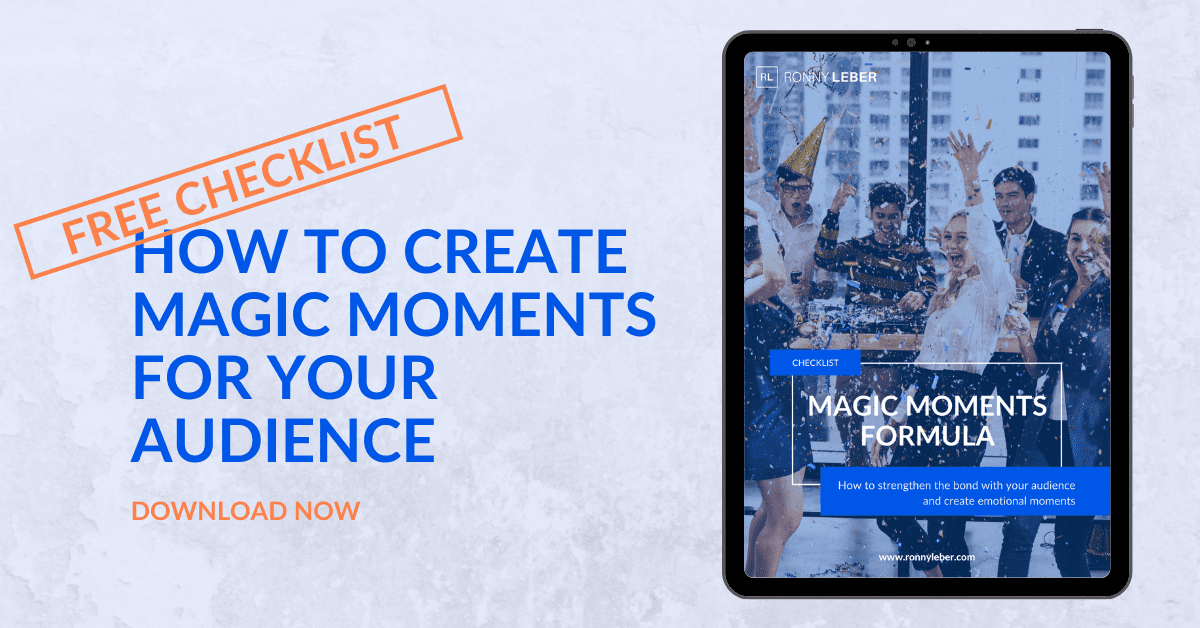
Stop guessing how to WOW your audience!
We will send you our secret ingredients to WOW your audience for free! In the MAGIC MOMENTS FORMULA you can learn how to take any audience of any size and create a deep emotional experience for them in order to create a deeper emotional bond with you and your brand.
The first impression is crucial for further success
There’s a saying that goes, “ There’s no second chance for a first impression. ” It takes between 100 milliseconds and 7 seconds for your audience to get the same impression of you. If you as a speaker fail to make that first impression, no matter how impressive your speech, it will be very difficult to pick up your audience.
US comedian Jerry Seinfeld , one of the most famous American comedians of the 90s, said that his fame only gives him a starting bonus for the first three minutes – at the latest then he has to deliver. If you don’t enjoy the celebrity bonus in your speeches, that means you have to deliver right from the get go to win over your audience.
Requirements for the ideal introduction for your speech
Before you can wow people as a speaker and give any thought to content, you need to set the stage. If you want to give a good speech and move your audience from A to B, two things are essential: you need to know where you want to go and where your audience is coming from .
Know the outcome of your speech
If you don’t know in which direction you want to move your audience, then no amount of tips will get you there. So before you tinker with the ideal introduction, you need to be clear about what your outcome is .

What feeling do you want the audience to have when you leave the stage? What impression do you want to convey as a speaker? Even more public speaking tips you can find here.
Know your audience members
If you want to catch a fish, you have to use a bait that tastes good to the fish, not to the fisherman . The same applies to presentations: who decides what is a top speech? That is, of course, in the eye of your audience. Therefore, it is all the more important to know who the people are, listening to your speech.

An American proverb says that your audience doesn’t care how much you know until they know how much you care. Your audience won’t pay attention to you until they see that your speech is relevant to them. As a speaker, do you bring examples and tips and answer questions in your main points that matter to the audience? Do your main ideas strike a cord?
Tip: Try to find out as much as possible to know in advance what moves your audience and why people are here today. If you have the opportunity, use the time for successful networking and listen to their needs.
The goal of an ideal introduction to your speech
Only after you know your outcome and your audience you can focus on how to start your presentation, because now you know as a speaker in which direction your ship should sail. If you want to give a speech, you need to get your audience interested in you and your main points. For this to happen, you need the attention of your audience.
Speaker Tip: First create attention , then develop interest in your message and your main points to make it worth listening for your audience.
Giving a speech: seven perfect speech introductions
Now let’s look at tips and examples of how you as a speaker can inspire your audience. These tips should give you a guideline from where you can successfully transition from your chosen introduction to the main part and final part of your speech.
1. He who asks, leads – starting with a question
An elegant way to begin a speech is with a question . The goal is to engage your listener directly in your opening and generate interest. In order for the question to be effective, it must be tailored to your target audience. The question may be provocative, surprising or even make you smile, but it must be relevant.

For example, if you’re speaking to a group of retirees, a question like “Which one of you went to a disco last weekend?” would be just as out of place as asking a group of Wall street brokers “Which one of you has been involved in stocks?”. Your audience needs to feel like you know who you’re dealing with.
“Who remembers what they did last Saturday night?” was an opening I chose many years ago when giving a speech. Of course, after that, there was a story about my Saturday night that fit right in with the theme of my speech. People were immediately involved and everyone was thinking. Because just about everybody did something last Saturday and so it was relevant… even if many didn’t even remember it.
With questions that fit the topics, you are sure to get the attention of the participants. However, always pay attention to what you trigger in your audience with a question and, if requested, also provide the appropriate answer.
Another speaking tip: When you ask a question, give your audience time to respond . Whether out loud, with a show of hands, or silently, people need time for what you say to have an impact. Of course, questions can also be used during your speech.
2. Start your speech with a quote
Using the words of another person in your speech is a proven way. The art of building a good speech is to pick up your audience where they are. A pointed quote that gets to the heart of your ideas or the occasion is the basic premise for choosing someone else’s statement as your lead-in. If people are familiar with the name of the person you are quoting, it gives you added credibility as a speaker.
Very similar to a quote is using a proverb to start your speech. Again, there is often a deeper wisdom behind it. Link this to the idea of your speech and you have a great introduction.
Again, I’ll give you an example from my own experience when I was asked to give a presentation on the topic of corporate mission statements many years ago. I decided to start with a quote, but the number of quotes on this topic are manageable. However, the corporate mission statement compares very well with the soul for people, and so on this occasion I found a quote on the subject of the soul and then drew the analogy with the corporate mission statement. “Outside the box” solutions are also the speaker’s friend.
3. Inspire your audience with storytelling
A particularly powerful way to start is to share a story or personal real life experience with your audience at the beginning of your presentation. With a personal story, you create compelling moments and build an emotional connection with your audience. However, this is also where the biggest danger lies: your story must absolutely correspond to the facts and at the same time should have a connection to the topic of the event. The audience has a good nose for it, if you serve them a “suitably made” story.
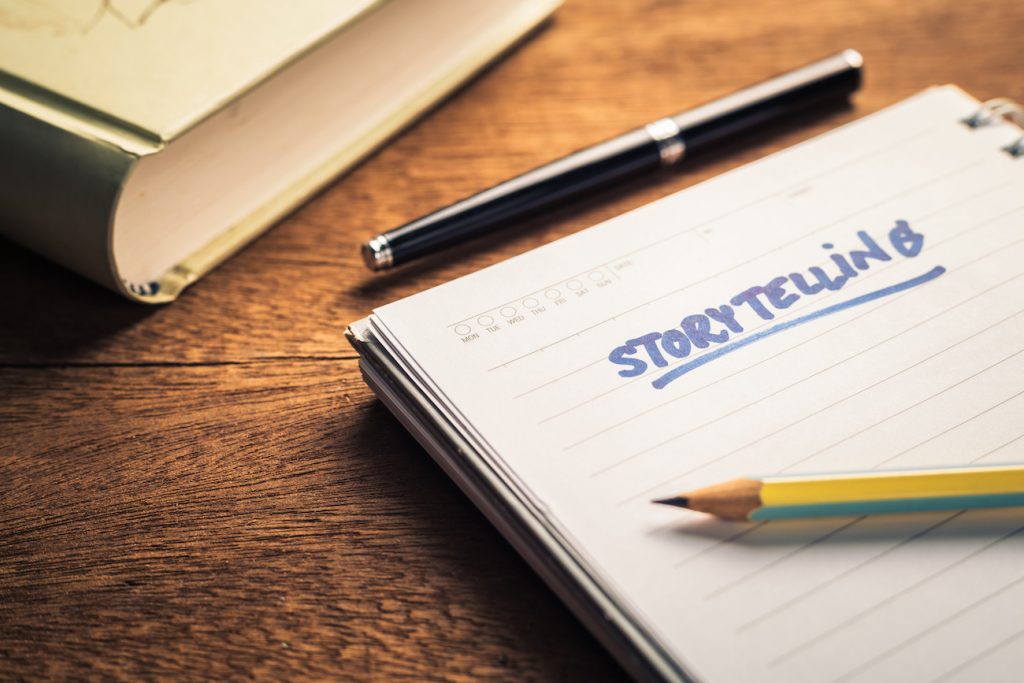
Of course, storytelling is not limited to stories you have experienced yourself. You can also draw on a current or even historical event. Important, as mentioned above, is the connection to the goal of your presentation. Also, make sure that you start right in the relevant event and do not begin with Adam and Eve. Especially extroverted people like to get into narration and then it can happen that you lose the drive to your actual presentation and your audience is no longer on the point.
One of my stage coaching clients, for example, took his audience into a situation right at the beginning of his speech when he was at the start of his first triathlon. He immediately built up a tension, because he put his audience directly into it instead of talking about preparation and planning for the triathlon. Because he also found the right tone, the speech went down great. Bonus tip for your speech: Stories absolutely need to be rehearsed and tailored to your audience and the occasion. This does not mean, as already mentioned, that you add things, but that you leave out unnecessary things. Don’t just tell from memory, but really practice.
4. Start with an open loop
Starting with an open loop is something like the supreme discipline. Here, you start with a story, but don’t finish telling it until the end of your speech . This type of introduction is certainly a bit unusual and, in my opinion, more suitable for experienced speakers, especially to keep the tension high.
You start with the open loop in the same way as with storytelling and take your audience along until the point where the tension is at its highest. Instead of the resolution, you lead into the topic of your speech and then come to the main part, where the content is presented with further examples. Only at the end do you pick up the ball of your introductory story again and close the open loop.
As an example, I start one of my keynote speeches with such an open loop: I take the audience on my experience at the New York City Marathon. Since my preparation for it was far from ideal due to injuries, I wasn’t sure until the start how far I would run that day. My speech started with the thoughts going through my head at the start, with my uncertainty but also anticipation. The start of the marathon was then the Open Loop, which I only resolved at the end of the speech.
5. Enchant the audience with parables
A parable is a very short to short story which might not even have a plot of its own. While a parable can be told with action, as if something has actually taken place, it can also be about something hypothetical: “Imagine…” or “Suppose…”. In both cases, the point is that we want to make a connection to the content.
The purpose of parables is to pick up the audience as they enter your presentation and provide an emotional experience that immediately introduces them to the topic through your words.
6. Facts, figures and statistics as an introduction for the speech
The FFS introduction is particularly useful if you have facts, figures or statistics that are not familiar to your audience and are also unusual. In addition, it must of course fit your topic and possibly support your thesis. A personalized statistic works best to meet your audience’s needs.

When we were designing the outline for one of my Executive Legacy Coaching clients’ investor pitch, we made a conscious decision to start with a number that would probably come as a surprise to many listeners. To back up the pain point that his product solves, he asked the panel how much they thought that an unhappy employee costs a company per year. Starting with that number was so effective because the audience’s estimates were all substantially lower than the true number, creating an a-ha effect.
7. Looking back
Another way to start your speech is with a look back . This variant is particularly suitable if you are to give a speech on the occasion of an anniversary or birthday. In your preparation, you should pay special attention to who is sitting in your audience: what connection do they have to the person or the company or the occasion and, above all, have they experienced the period themselves.
Some time ago, I had the privilege of being on stage at a company’s 20th anniversary. In order to give the audience as emotional an experience as possible, I first had to find out who was in the audience. Have people lived through these last 20 years, and are they likely to remember the moment from 20 years ago? Since my audience was mostly over 35 years old I assumed that was the case. Thus I dove into the world of 20 years ago: how did the world look and what moved people at the time? Immediately the people were in the emotions of the memories and from that I could then draw a bow to the company anniversary: “much has changed, but one thing has remained the same…”.
Giving a speech: here’s what you should avoid when getting started
Jokes are for comedians.
There are talented joke tellers and there are those who always flub the punch line. If you feel uncomfortable in the role of the joker, don’t do it. However, that doesn’t mean you can’t spice up the introduction with a little humor. Humor arouses positive emotions and loosens the atmosphere. A humorous introduction, which also works without a joke, signals to the participants that the event will not be dry as dust and that it is worth staying for.
Bonus tip: Humor is different in different regions and works best when you approach your audience with respect and humility.
Stay away from provocative introductions
A provocative introduction is like riding on a razor blade: very dangerous. You have to have an incredible ace up your sleeve to win your audience back. As a rule, I would strongly advise you not to use provocative introductions. If your audience perceives you as an unsympathetic person, no matter how ingenious the content of your speech, it will not bring the desired success.
Start with an apology
Some insecure speaker starts his speech with an apology for his insecurity or God knows what else. Please don’t do that. For one thing, the audience usually doesn’t notice it anyway, and for another, it immediately takes something away from your first impression. You might get sympathy for it, but in the rarest cases you will get the attention for your speech.

One of the most important tips I once received was that your audience wants you to win . That’s right, you read that correctly. Your audience wants you to be good. No one sits in the audience hoping for a boring speaker to come on now. Your audience wants you to do your job well. If you feel anxiety on the way to the stage, keep reading.
The way to the stage and the first seconds
The key to a perfect introduction lies not only in the preparation for your speech, but also in the emotional preparation in the moments before public speaking. Especially if you are nervous or even feel speech anxiety , it is even more important that you, to present convincingly, are in an ideal state.
Take a deep breath just before your performance, send positive emotions to your audience and off you go. Many speakers also like to take index cards with their notes to be prepared in case of an emergency. The phrase for the introduction as well as for the conclusion I would always write in full. For the main points, keywords are enough here.
When you finally arrive on stage, at first be aware of your audience . Before you begin, start with eye contact and confident body language to radiate stage presence . Only then, when you feel the attention of your audience, you start to talk. This confidence will automatically boost your credibility.
Bonus tip: if you’re unsure about your voice, a little voice training will help.
The ideal start for your virtual speech
Of course, the principles for your ideal start also apply at virtual events. So if you hold a webinar or a virtual presentation or are on stage at a hybrid event , nothing will change in the structure of your preparation. The main point in the virtual space is that you have to speak in front of the camera and this should be practiced. The specific elements of structuring your presentation stay the same.
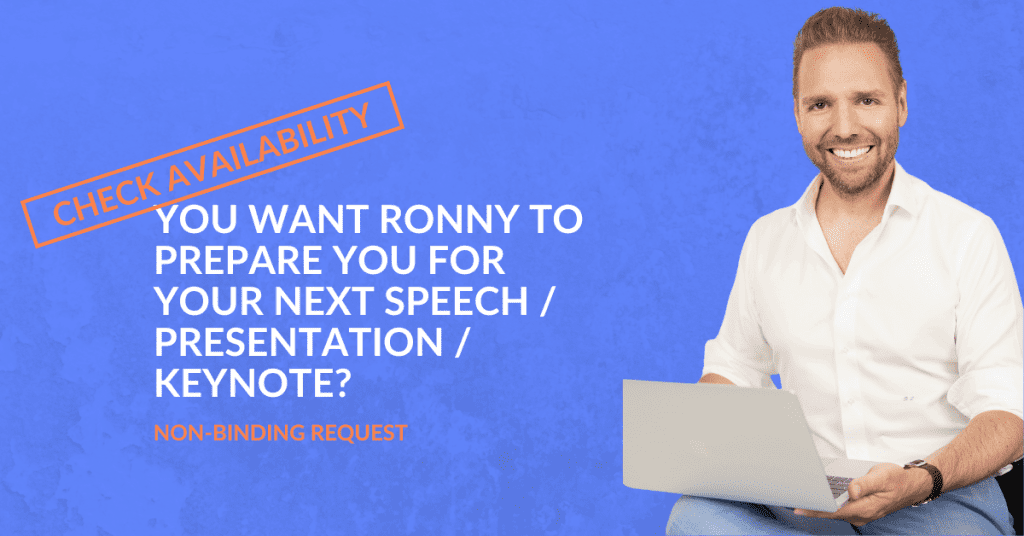
Ask Ronny to coach you for your next performance
Click on the button and send a non-binding request to Ronny to be your coach for your next keynote, speech or presentation.
Feeling ready for your next speech?
In this article you have learned how to start your speech in an ideal way. Do you already have an idea which structure you like best? Remember that you always start with your outcome and your audience before you create a thread for your presentation.

The tone makes the music. Former American writer Maya Angelou summed it up this way: “Your audience won’t remember exactly what you said, but they’ll always remember how it made them feel.” Whatever the occasion, take your audience on an emotional journey.
If you feel that you still need help for your next speech or keynote , feel free to contact me or just write me an e-mail ! Together many things are easier.
Which introduction appeals to you the most? Which start to a speech have you learned about here and would like to try out for your next performance? Please leave a comment below and share this article with someone who you think will profit from it. All the best for your next speeches.
There is no second chance for a first impression . The first impression is created in the first few seconds of perception and is crucial to whether your audience perceives you as likeable or unlikeable. If you mess up the first impression, the next few minutes will be a steep uphill climb to get the audience back on your side.
First, take three deep breaths and consciously put a smile on your face. Stand up straight, shoulders back, head up and visualize your audience and your goal. The important thing here is to move as quickly as possible from an internal focus (thinking about you) to an external focus (thinking about your audience). Imagine how your audience will benefit from your speech. For even more tips, I recommend you read my blog post Persuasive presentations: 3 Steps to Your Ideal State in Front of an Audience.
Ideally, you were introduced by a presenter who has also given some interesting background information about you to the audience. However, it always makes sense to leave nothing to chance here and, on the one hand, to discuss your introduction with the presenter upfront and, on the other hand, to include the most important points in your speech. I would always start with an introduction into the topic to get the audience interested and then introduce myself. The best way to find the right introduction is to read this article.
How useful was this post?
Click on a star to rate it!
Average rating 4.3 / 5. Vote count: 44
No votes so far! Be the first to rate this post.
Similar Posts

The golden dozen of video conference tips that will help you win every video conference!
Stop guessing how to WOW your audience!The first impression is crucial for further successRequirements for the ideal introduction for your speechKnow the outcome of your speechKnow your audience membersThe goal of an ideal introduction to…

Voice training: 5 things that improve your voice now!
Voice training helps you professionally, but also in your everyday life. Find out the best ways to improve your voice here.

How do you become a motivational speaker? In 5 steps to your first motivational speech!

Overcome stage fright once and for all! Get rid of performance anxiety with these simple tricks!

Nonverbal communication tips – The secret of good body language

Persuasive presentation: In 3 steps to your ideal state to inspire your audience
Leave a reply cancel reply.
Your email address will not be published. Required fields are marked *
Save my name, email, and website in this browser for the next time I comment.

- About Ronny
- Our Clients
- Our Core Values
- STAGE HERO Coaching
- Homestudio Resources
© 2024 RLE Business GmbH. All rights reserved | Imprint | Privacy Policy

Session expired
Please log in again. The login page will open in a new tab. After logging in you can close it and return to this page.
INQUIRE NOW
Request Ronny as a keynote speaker for your next event without obligation!
CHECK AVAILABILTY
Send us a non-binding inquiry for Ronny to coach you for your next keynote, speech or presentation!
Send us a non-binding request for Ronny as host for your next event!
STOP GUESSING HOW TO WOW YOUR AUDIENCE
Join our e-mail list for free to get the MAGIC MOMENTS FORMULA for free!
STOP GUESSING WHICH TECH TO USE IN YOUR HOME STUDIO
Join our e-mail list for free and we will send you the newest HOME STUDIO ASSISTANT checklist directly to your inbox. Each item has been carefully selected.
STOP GUESSING WHO THE RIGHT KENOYTE SPEAKER FOR YOUR EVENT IS
Join our e-mail list for free and get your 18-page KEYNOTE SCOUT-checklist on how to find the ideal keynote speaker for your event
STOP GUESSING ABOUT YOUR IDEAL EVENT HOST
Join our e-mail list for free and get your free EVENT HOST SCOUT - checklist to find the ideal event host“.
YES! I'M IN!
Join our e-mail list for free to get inspiring tips for speakers, presenters and event organizers!
- PRO Courses Guides New Tech Help Pro Expert Videos About wikiHow Pro Upgrade Sign In
- EDIT Edit this Article
- EXPLORE Tech Help Pro About Us Random Article Quizzes Request a New Article Community Dashboard This Or That Game Forums Popular Categories Arts and Entertainment Artwork Books Movies Computers and Electronics Computers Phone Skills Technology Hacks Health Men's Health Mental Health Women's Health Relationships Dating Love Relationship Issues Hobbies and Crafts Crafts Drawing Games Education & Communication Communication Skills Personal Development Studying Personal Care and Style Fashion Hair Care Personal Hygiene Youth Personal Care School Stuff Dating All Categories Arts and Entertainment Finance and Business Home and Garden Relationship Quizzes Cars & Other Vehicles Food and Entertaining Personal Care and Style Sports and Fitness Computers and Electronics Health Pets and Animals Travel Education & Communication Hobbies and Crafts Philosophy and Religion Work World Family Life Holidays and Traditions Relationships Youth
- Browse Articles
- Learn Something New
- Quizzes Hot
- Happiness Hub
- This Or That Game
- Train Your Brain
- Explore More
- Support wikiHow
- About wikiHow
- Log in / Sign up
- Education and Communications
- Communication Skills
- Public Speaking
- Speechwriting
How to Write a Speech Introducing Yourself
Last Updated: June 24, 2024 Fact Checked
This article was co-authored by Lynn Kirkham . Lynn Kirkham is a Professional Public Speaker and Founder of Yes You Can Speak, a San Francisco Bay Area-based public speaking educational business empowering thousands of professionals to take command of whatever stage they've been given - from job interviews, boardroom talks to TEDx and large conference platforms. Lynn was chosen as the official TEDx Berkeley speaker coach for the last four years and has worked with executives at Google, Facebook, Intuit, Genentech, Intel, VMware, and others. There are 15 references cited in this article, which can be found at the bottom of the page. This article has been fact-checked, ensuring the accuracy of any cited facts and confirming the authority of its sources. This article has been viewed 3,826,043 times.
First impressions have a big impact on how others perceive you, so how you introduce yourself to others is extremely important. Many people call an introductory speech an elevator speech, because it should be succinct enough that you could introduce yourself and tell someone about your goals or interests in the time it takes to ride an elevator. It may also be called an "icebreaker" speech, as it breaks the ice and lets others get to know you. [1] X Research source Consider your words carefully when you write a speech introducing yourself. Crafting a good self-introduction can either build or harm your credibility.
Sample Speeches

Preparing Your Speech

- State your name in the very first sentence of your speech. This can be very straightforward: "Good afternoon!/Good morning! My name is Deshawn Smith, and I am a computer programming student at the University of Arkansas."
- If the introduction is work-related, mention your interests and your career goals together in the same sentence. This will save on time and convey that your personal interests can serve your professional goals. For example, "I am working on an app that allows people to order pizza from their Twitter account."
- You may want to mention your education or professional training background, if it is relevant and appropriate. "This is the fifth app I've designed. My second app, which helped people locate dog parks near them, won an award at my university."

- If you are explaining your passion or goal and how it helped formed your progression up to this point, that can help you tell a compelling story about yourself. For example, if you're writing a speech for your college speech class , you might want to explain how you got into computers at an early age and why they're important to you now as you pursue your career goals.
- If, however, you are introducing yourself to potential clients at a business lunch, they are probably not interested in your hobbies. They will want to know what you are doing right now and what your skills are.
- Try writing one draft with your experience/hobbies and one without, and run both versions by an objective listener who can give you feedback before your speech.

- Highlight the qualities, skills and experience you have that are most relevant for the audience and occasion. For example, "Because of my background in app writing and my extensive network of professional connections, I have a strong grasp of what today's young professionals are looking for. My apps offer convenience and immediate gratification."
- You are trying to present yourself as a professional while making a strong and lasting impression.
- If you're trying to sell yourself to a group of new colleagues, you probably won't need to tell them about your family life, or anything outside of work that isn't directly relevant.

- You can simultaneously demonstrate your skills and experience, while presenting yourself as a forward-looking person who is always learning and developing. For example, you could say, "I spend a lot of time attending app conventions and conferences so I can learn what audiences are looking for. I pride myself on staying on the cutting edge of app design."
- Try to tie this into your broader outline of your career goals and personal development.
Revising and Practicing Your Speech

- Make sure that if this is an assignment, you stay within the assigned guidelines.
- If your speech is supposed to be 3-5 minutes, a 7-minute speech and a 2-minute speech are equally inappropriate.
- If you are giving a brief introductory speech in an interview , be certain that you don't go over the recommended time.

- Avoid long rambling sentences, and use direct and concise prose as much as possible.
- Think about your sentence structure carefully. Reading your speech out loud will help you determine when you have overly long sentences that need to be restructured.

- Practicing in front of other people will enable you to gauge whether your speech captures the interest of your listeners.
- Think about which parts of the speech were successful and which parts weren't.
- Try to get as much detailed feedback as possible by asking specific as well as general questions after your speech.
- As well as saying "how did you like the speech?", ask specifically what parts were the strongest and weakest.
- Check that you delivered a clear message by asking your practice audience what they took away from the speech.

- If you are staring down at a piece of paper all the time, the audience might struggle to truly engage with what you are saying.
- You can, however, bring an index card with bullet points, just in case you freeze up. You shouldn't write your whole speech on the card, just the main points you hope to cover.
- Think of the card as a point of reference, rather than a backup for your speech.
Planning Your Speech

- Who is the intended audience?
- What is the purpose of my introduction?
- What are the expectations others may have?

- Stick to one or two main points you want to convey about yourself. You can always add more if time allows it.
- Depending on the audience and function of your speech, you shouldn't allow the focus to become too narrow. For example, if you're introducing yourself to a crowd of prospective investors, you'd focus on your skills to build their confidence in you. If you're introducing yourself to a general audience -- say, for a speech class in college -- you can be a bit more wide-ranging.
- Remember that you're introducing yourself in general, and you want to present yourself as an interesting and rounded individual. [12] X Research source
- That doesn't mean you should spend time talking about your love of baseball when you are introducing yourself in a professional scenario.

- Are you hoping to win someone over to your point of view with this introduction, or to inspire/motivate someone to work hard under your leadership?
- All of these will affect the things you say in your introduction and the way you say them. [14] X Research source
Delivering Your Speech

- You can also try some visualization techniques to help ease your nervousness and give you confidence for your speech.
- Imagine the way you will feel when you have finished delivering your speech and are met with smiling faces and resounding applause. Then channel that confidence into the actual speech you are about to deliver.

- Avoid crossing your arms or clutching your hands.
- Don't stare down at the ground or cling to the table or lecture in front of you.
- Make eye contact across the room in a measured and controlled way. Avoid lingering on one person, but also avoid darting your eyes back and forth restlessly.
- Try making eye contact with one person on the left side of the room, then one person on the right side of the room. Shift across the room, but in a controlled way that feels natural and relaxed.

- Aim for a comfortable, conversational pace of dialogue.
- Practicing your speech in front of other people, or recording it and listening back are great ways to judge the tempo of your speech.

- Self-deprecating humor can help you come across as humble and likable. For example, if you've accidentally skipped forward in your speech and have to circle back, you could say something like, "And now I'm going to cycle back and tell you something I forgot before. If you wanted to get to know the "real me," you're seeing it now!"
- You can also make a quick, humorous nod to your mistake and move on. For example, if you come out and you mess up the very first line, you could say something like, "Wow, excuse me. Here I am so excited to tell you about myself that I've mixed up all my words. Let me try that again."
- Don't be too self-deprecating, however. You are still trying to ensure people remember you for your strengths and competencies. Move on quickly.
Expert Q&A

Reader Videos
Share a quick video tip and help bring articles to life with your friendly advice. Your insights could make a real difference and help millions of people!
- Improve eye contact with the audience. Be direct and move confidently during the speech. Thanks Helpful 21 Not Helpful 3
- Do not be afraid to make yourself sound good. After all, this is an introduction, and the first impression you will make. Thanks Helpful 24 Not Helpful 4
- If the introduction is too long, you will lose your audience's attention. A good introduction should be short and to the point. Thanks Helpful 20 Not Helpful 6

You Might Also Like

- ↑ https://courses.p2pu.org/en/groups/public-speaking-2/content/icebreaker-introduce-yourself/
- ↑ https://courses.lumenlearning.com/publicspeakingprinciples/chapter/chapter-8-outlining-your-speech/
- ↑ https://www.indeed.com/career-advice/interviewing/how-to-give-an-elevator-pitch-examples
- ↑ https://www.forbes.com/sites/serenitygibbons/2023/05/31/3-tips-to-set-yourself-apart-with-unique-branding/?sh=5421a3b03baa
- ↑ https://www.hamilton.edu/academics/centers/oralcommunication/guides/shortening-a-speech
- ↑ https://writingcenter.unc.edu/tips-and-tools/speeches/
- ↑ https://www.unr.edu/writing-speaking-center/student-resources/writing-speaking-resources/speech-delivery
- ↑ Lynn Kirkham. Public Speaking Coach. Expert Interview. 20 November 2019.
- ↑ https://courses.lumenlearning.com/wm-publicspeaking/chapter/methods-of-speech-delivery/
- ↑ https://www.comm.pitt.edu/oral-comm-lab/audience-analysis
- ↑ https://open.lib.umn.edu/writingforsuccess/chapter/6-1-purpose-audience-tone-and-content/
- ↑ https://pac.org/content/speechwriting-101-writing-effective-speech
- ↑ https://sps.columbia.edu/news/five-ways-improve-your-body-language-during-speech
- ↑ https://www.apa.org/monitor/2017/02/tips-speaking
- ↑ https://professional.dce.harvard.edu/blog/10-tips-for-improving-your-public-speaking-skills/
About This Article

To write a speech introducing yourself, start by organizing the information you want to include. When writing content, consider the purpose of the speech, your intended audience, and your goals for the introduction. You can speak about your education, professional background, career/career goals, and outside interests, but keep things brief and to the point. Only include information that is important and relevant to your listeners. Don't forget to state your name in the first sentence of the speech. To learn more from our English Ph.D. co-author, such as how to practice and memorize your speech, continue reading the article! Did this summary help you? Yes No
- Send fan mail to authors
Reader Success Stories
Rebecca Steudeman
Feb 27, 2017
Did this article help you?
Rose Martinez
Oct 26, 2018
May 26, 2017
Kutmanai Kutia
Jul 17, 2018
Joseph Johnson
May 16, 2017

Featured Articles

Trending Articles

Watch Articles

- Terms of Use
- Privacy Policy
- Do Not Sell or Share My Info
- Not Selling Info
wikiHow Tech Help Pro:
Develop the tech skills you need for work and life

IMAGES
VIDEO
COMMENTS
How to write a speech introduction. 12 of the best attention getters to start a speech. By: Susan Dugdale | Last modified: 01-12-2023. The audience settles in their seats. The lights dim. You walk out to the center of the stage. You pause, take a deep breath, open your mouth and begin.
4. Introduction Speech Example. 5. Introduction Speech Ideas. 6. 7 Tips for Delivering the Best Introduction Speech. What is an Introduction Speech? An introduction speech, or introductory address, is a brief presentation at the beginning of an event or public speaking engagement.
Logical orientation. Once the audience is invested in the speech, logical orientation tells the audience how the speaker will approach and develop the topic. Your thesis needs to be stated clearly and concisely. Peanut butter on both sides of the bread with jelly in the middle is the best way to make a PB&J.
The introduction of a speech is incredibly important because it needs to establish the topic and purpose, set up the reason your audience should listen to you and set a precedent for the rest of the speech. Imagine the first day of a semester long class.
Here's how to write an introduction to make it powerful. There's a moment of high drama when you give a speech or presentation—and it occurs before you've even said a word. It's the first few seconds when the "curtain" goes up. In other words, it's all about anticipation.
A powerful introduction builds trust and engagement from the beginning. Here are proven ways to start your speech that will keep your audience interested from start to finish. Introduction Speech Attention Getters. These carefully selected speech openings show different ways to capture audience attention from your first word. 1. The Personal ...
Listen up, audience! No matter whether you are giving an informative speech to enlighten an audience about a certain topic or a persuasive speech aims to convince the crowd to adopt a particular viewpoint. But whichever type of speech you’re writing or delivering, one thing is true: You must create an attention-grabbing speech introduction.
Learning Objectives. Clearly identify why an audience should listen to a speaker. Discuss how you can build your credibility during a speech. Understand how to write a clear thesis statement. Design an effective preview of your speech’s content for your audience. Erin Brown-John – puzzle – CC BY-NC 2.0.
Requirements for the ideal introduction for your speech. Before you can wow people as a speaker and give any thought to content, you need to set the stage. If you want to give a good speech and move your audience from A to B, two things are essential: you need to know where you want to go and where your audience is coming from.
1. Make an outline of your speech. Start by making a skeletal draft of your main points. Strip the speech down to its bare bones to determine what is most important to say, and in what order you should deliver those facts. This is the basic structure which you will build your speech around. [2]